




























Expertise - Passion - Automation 88 ANZ Sales People Let the facts speak for themselves 5 Countries R&D Centres 1,450 Engineers 18 Engineers in ANZ 81% Countries 7,900 Sales People 700,000 Variations 10 ANZ Branches 28 Production Locations 5 Local Production Facilities 12,000 Products DECEMBER 2022
Choose the world leader in pneumatic automation for your next project.

SMC Corporation offers a commitment to Japanese quality, customer centric design, local manufacturing and unmatched commercial support.
It’s no wonder SMC was voted as one of the Forbes Top 100 Most Innovative Companies. Let the facts speak for themselves.
SMC - more than pneumatics

- Passion
www.smcanz.com
Expertise
- Automation
SMC Corporation Australia | New Zealand Group
When it comes to your food and beverage facility... Why would you settle for second best?
Renewed focus on Australian manufacturing


DECEMBER 2022 PLUS: Cold Chain | Machinery | Alternative Packaging
CEO: John Murphy
COO: Christine Clancy
Group Managing Editor (Northern): Syed Shah
Editor: Adam McCleery

Ph: (02) 9439 7227
adam.mccleery@primecreative.com.au
Design Production Manager: Michelle Weston
michelle.weston@primecreative.com.au
Art Director: Blake Storey
Designers: Kerry Pert, Tom Anderson
Sales/Advertising: Stephanie Suzuki
Ph: +61 422 046 711
stephanie.suzuki@primecreative.com.au
Production Coordinator: Janine Clements
Ph: (02) 9439 7227
janine.clements@primecreative.com.au
Subscriptions AUS NZ O/S
1 year subscription 99 109 119 2 year subscription 189 199 209
For subscriptions enquiries please email subscriptions@primecreative.com.au
Local manufacturing continues to see growth
Copyright
Food & Beverage Industry News is owned by Prime Creative Media and published by John Murphy. All material in Food & Beverage Industry News is copyright and no part may be reproduced or copied in any form or by any means (graphic, electronic or mechanical including information and retrieval systems) without written permission of the publisher. The Editor welcomes contributions but reserves the right to accept or reject any material. While every effort has been made to ensure the accuracy of information, Prime Creative Media will not accept responsibility for errors or omissions or for any consequences arising from reliance on information published.
The opinions expressed in Food & Beverage Industry News are not necessarily the opinions of, or endorsed by the publisher unless otherwise stated.
© Copyright Prime Creative Media, 2019
Articles
All articles submitted for publication become the property of the publisher. The Editor reserves the right to adjust any article to conform with the magazine format.
Head Office 379 Docklands Drive Melbourne VIC 3008
Ph: +61 3 9690 8766
enquiries@primecreative.com.au http://www.primecreative.com.au
Sydney Office Suite 303, 1-9 Chandos Street Saint Leonards NSW 2065, Australia Ph: (02) 9439 7227
Editor:
Adam McCleery
Welcome to the December edition of Food & Beverage Industry News. The special feature for the last issue of 2022 is centred around the theme of Australian made, the importance of which has grown in recent years.
In the wake of the COVID-19 pandemic many processes within the food and beverage manufacturing sector are undergoing changes to mitigate the same risks in the future, namely those around access to materials and goods.
The impact on the supply chain, especially the international, has been widely covered during and since the end of the pandemic but the ramifications are still being felt as producers and manufacturers continue to make changes.
As I’ve discovered while speaking with a number of stakeholders in the industry, finding local sources for materials and product is becoming more critical than it had pre-COVID.
There are several factors for the renewed focus on Australian made but a common thread I am always finding is the confidence that sourcing local gives to the supply chain, because there is less risk of major disruptions like those still being felt.
On top of the pandemic factor, is the growth in innovation, connectivity, and automation. As producers and manufacturers continue to adopt newer and more efficient solutions their capabilities grow. The trickle-down effect sees local companies expanding, leading to more investment in the local industry and market.
Stakeholders have also said that several their
clients are now eager for locally made products and pieces of machinery, with the parts also being available locally, in order to mitigate the risk of a backlog.
In a highly competitive environment like the Australian food and beverage market, any lost time is very costly, meaning being able to source what you need quickly is of paramount importance.
Then there is the issue of supply chain cost. As inflation continues to climb and the cost of moving material and product from country-to-country increases, companies are looking at better and more affordable solutions. This is likely another driver in a renewed focus on finding locally made products.
International supply chains will no doubt experience some rebound in the coming year, however the impact of the last handful of years and the flaws that have been discovered as a result have also likely set into motion a new perception of how to balance both local and international supply chains to mitigate the risks associated with both.
The first half of 2023 will be an interesting one, from an economic standpoint, and if the industry continues to react with agility to the changes, then I foresee another bumper year of expansion and innovation.
Covering the industry throughout 2022 has been a great experience which has taught me a lot.
I look forward to what 2023 will bring for the Australian food and beverage industry.

Until next year. Happy Reading!
Printed by: Manark Printing 28 Dingley Ave Dandenong VIC 3175 Ph: (03) 9794 8337

WELCOME
4 Food &Beverage Industry News | December 2022 | www.foodmag.com.au


1300 007 224 | info@pbbg.com.au | paulbrady.com.au
We build food facilities from end-to-end and deal with everything in between.
18
MEET THE MANUFACTURER
The Bondi Brewing Co is finding great success in the competitive brewing space and continues to partner with other companies.

22
MACHINERY
Industrial innovator Schaeffler is helping combat labour shortages and increasing cost of production.
PACKAGING
COPAR continues to see the popularity of wheat straw as a viable packaging option grow in Australia, and abroad.
SUSTAINABILITY
SMC Corporation Australia New Zealand has built a strong reputation for helping companies reach sustainability targets.

FLOWMETERS
AMS Instrumentation and Calibration brings Katronic’s flowmeters to the Australian market.
WAREHOUSING
CBRE Australia is working with the industry on the challenges around the supply and demand of industrial space.
CRYOGENIC FREEZING
Air Liquide has extensive knowledge and expertise in in designing cost-efficient cryogenic solutions.
ENGINEERING
Niras continues to provide the Australian industry with specialist and multi-disciplinary engineering solutions.
COLD CHAIN
Paul Brady Build Group’s solutions for cold storage have proven popular with the food and beverage industry.

38 CONSTRUCTION
Total Construction’s insight into the challenges of cold chain facilities and how best to utilise the space moving forward.



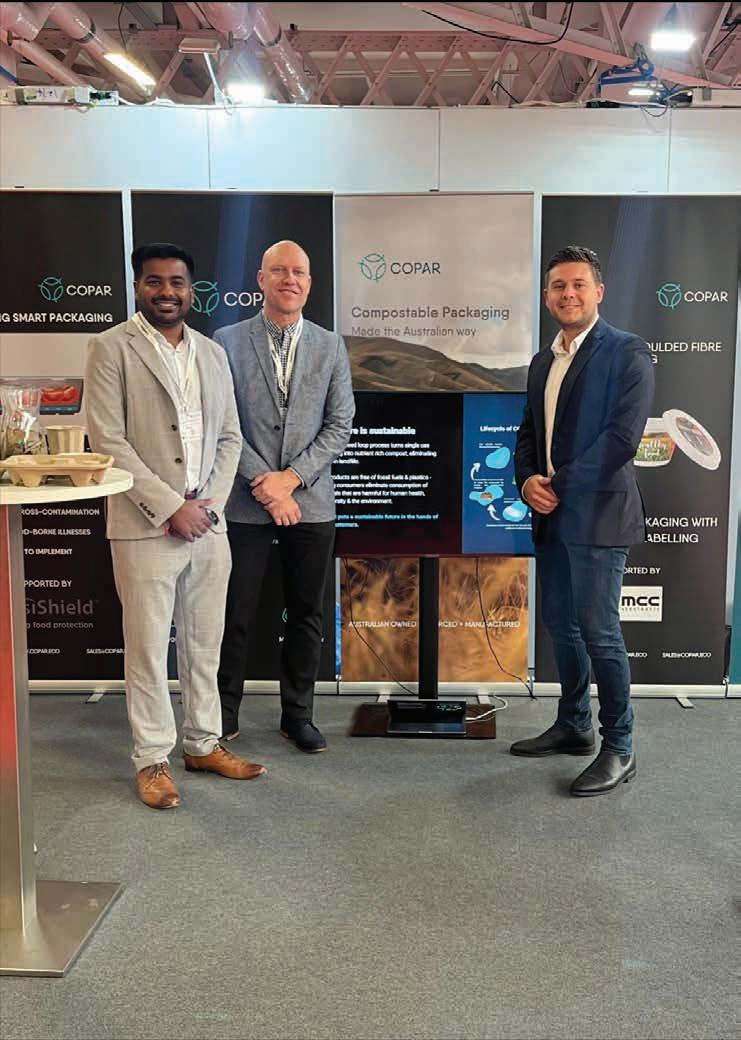

6 Food &Beverage Industry News | December 2022 | www.foodmag.com.au
08 NEWS
42
18 24 34 30
40 AIP 41 DAIRY
NEW PRODUCTS
NIRAS is a leading independent advisor within the Food & Beverage industry when it comes to investments, projects execution, production optimization, sustainable solutions, and green energy transition of your manufacturing facility. We can draw on our specialists across the world, but our local experts know the exact conditions and challenges of your local context. • Excellence in project delivery • Local support with a global mindset • Leading in sustainable solutions • Strategic masterplanning • Smart upgrades • Optimization and automation • Robust manufacturing • Electrification of industrial production • Green energy transition www.niras.com/sectors/food-and-beverage/
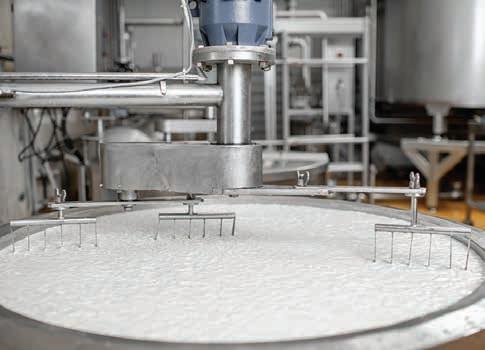
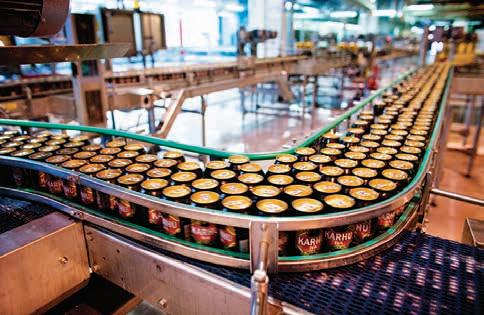

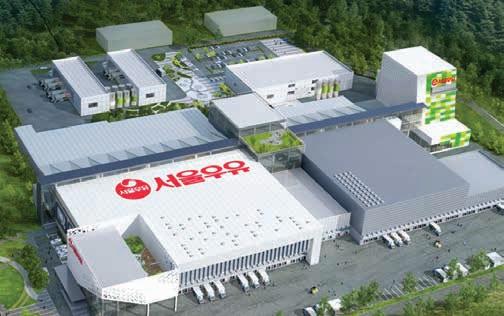


Managing Director Melbourne, Australia +61 488 786 484 EDLY@niras.com


Market Director


Melbourne, Australia +61 451 125 223 GLJA@niras.com
 Glenn Jacobsen
Edward Lynch
Glenn Jacobsen
Edward Lynch
Arnott’s Group and CleanPeak Energy to deliver behind the meter solar and battery installations
The Arnott’s Group and CleanPeak Energy have signed an agreement to transition the worldclass Huntingwood manufacturing facility to 100 per cent renewable electricity by 2029.
The 44,000sqm manufacturing facility operates 24-hours, seven days a week, running five different automated manufacturing lines, producing around 53 per cent of The Group’s total biscuit volume. The site employs over 400 people and bakes around 56 million kilograms of biscuits annually, including some of Australia’s favourites like Tim Tam, Shapes and Jatz.
CleanPeak will install a 4.1 MW rooftop solar system which will operate alongside a 15 MWh battery energy storage system, generating more than 5.25 GWh of renewable electricity. CleanPeak will then source an additional 17.3 GWh of mixed renewable and
non-renewable electricity required for the site, progressively moving to renewable electricity from 2023, and reaching 100 per cent by 2029.
The rooftop of the multi-building facility will house around 10,000 panels and be connected to inverters and a battery energy storage system. The integrated solar and battery assets will operate to smooth the solar output each day in-order-to match the energy usage of the site.

The Arnott’s Group, supported by energy consultant World Kinect Energy Services, embarked on the journey to transition to renewable electricity across their operations over 12 months ago.
CleanPeak was selected as The Group’s partner to deliver an onsite solution and compliment this with a multiyear in-front-of-meter energy offer that will allow the site to transition to 100 per cent renewable electricity
operations in a cost-effective manner.
CleanPeak’s capital investment will give the Arnott’s Group certainty over the site’s electricity costs for the next
seven years.
Building works will begin in the coming months, with the installation due to be fully operational by the end of 2023. F
Pact’s billion bottle recycling project wins award
The Pact Group has won a major sustainable project award for bringing Australia’s biggest and most advanced PET plastic recycling facility to life in just 370 days.
Pact was awarded the Australian Institute of Project Management’s Sustainable Project Management Achievement Award for NSW for the $50 million Circular Plastics Australia (CPA) PET plastic recycling facility in Albury.
The CPA facility is a joint venture between Pact, Cleanaway Waste Management, Asahi Beverages and CocaCola Europacific Partners (CCEP).
A team from Pact project managed the build, which was delivered safely, on time and under budget on a greenfield
site during a period of major global challenges, including the COVID-19 pandemic, supply chain pressures, and the blockage of the Suez Canal.
Despite these challenges, it took one year and five days to establish the site, construct the facility, install the equipment and services, commission the machinery, and train a new team.
The facility, which commenced operations in February 2022, has the capacity to recycle the equivalent of around 1 billion 600ml PET plastic beverage bottles each year into highquality food-grade resin.

Cleanaway collects, sorts and delivers PET plastic waste from kerbside collection bins and container deposit
schemes to the Pact-operated facility for recycling. The recycled resin is then used by Asahi and Coca-Cola to manufacture
make new beverage bottles and food packaging. F
NEWS 8 Food &Beverage Industry News | December 2022 | www.foodmag.com.au
Construction on the project is expected to begin in the coming months.
The Pact facility can recycle the equivalent of 1 billion 600ml PET bottles each year.
Beneficial Beer Co partners with fintech company BetaCarbon
Beneficial Beer Co has struck a deal with BetaCarbon, an Australian fintech company enabling retail investors to take part in the Australian carbon market.
Beneficial Beer Co is the first FMCG brand to partner with BetaCarbon in a deal that will see BetaCarbon QR codes on all its Stone Cold Lager cans, encouraging customers to redeem 100 free Australian Carbon Tokens (BCAU).
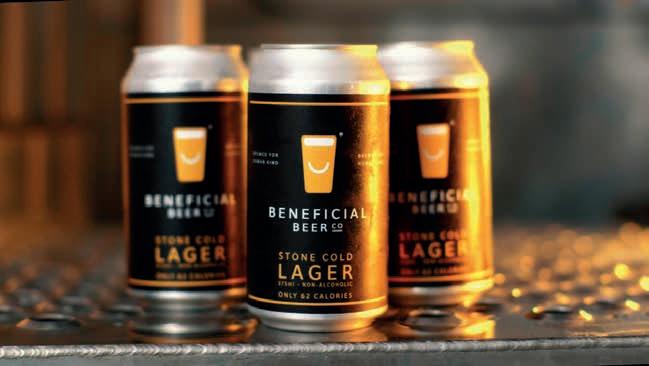
BetaCarbon offers the world’s first digital token based on regulated carbon credit.
It converts Australian carbon credits into Australian Carbon Tokens, with each token representing 1 kg of CO2 that has been avoided or removed from the atmosphere. 1000 BCAUs are
equivalent to one Australian Carbon Credit Unit.
Founded last year by ex-HSBC managing director Guy Dickinson, BetaCarbon was born to give the public exposure to an asset class that previously was only available to wholesale investors.
From the outset, Beneficial Beer Co’s founder and serial entrepreneur David Jackson knew he wanted his business to be a driving force for good.
Driven by the value of ‘Brewed for Humankind’, Beneficial Beer Co works with solar-powered brewing partners and actively recycles spent production grain to feed local livestock, with the latest BetaCarbon partnership another string to the company’s sustainability bow.
The funding will be used to produce
Nestlé to plant 10 million trees in Australia by 2025
Nestlé announced at COP27 Biodiversity Day that it aims to plant 10 million trees in Australia by 2025 in partnership with Greening Australia, Canopy and One Tree Planted.
The ambitious project is part of Nestlé’s Global Reforestation Program, which aims to plant and grow 200 million trees globally by 2030 as part of the company’s efforts to achieve net zero emissions.

Establishing the 10 million trees, a biodiverse mix of native species will sequester an estimated 2.1 million tonnes of CO2 over a 25-year carbon crediting period. Averaged over the project lifetime, this is equivalent to fuel emissions from over 25,000 cars each year.
The partnership between Nestlé, Greening Australia, Canopy and One Tree Planted will ensure that the trees are monitored across 28 years as they mature, delivering long-term environmental and economic benefits.
Working in collaboration with local landholders and communities, the 10 million trees will restore local biodiversity,
improve water quality and enhance degraded soils.
Trees will be planted in locations linked to regional areas where Nestlé sources its raw materials and will be registered by Greening Australia’s environmental markets business, Canopy, for carbon credits with Australia’s Clean Energy Regulator.
Nestlé’s Reforestation Project in Australia has commenced, with plantings underway with private landholders in the Strzelecki Ranges and in East Gippsland, Victoria.
Nestle’s reforestation initiative plays a significant part in the company’s global goal to meet net zero emissions by 2050, outlined in Nestle’s Net Zero Roadmap.
As part of Nestlé Australia’s progress towards 2050, in 2021 it switched to sourcing 100 per cent renewable electricity – avoiding around 73,0002 tonnes of carbon emissions each year.
Nestlé Australia is also transitioning 100 per cent of its packaging to be recyclable or reusable and more than 90 per cent of its packaging is now designed for recycling. F
NEWS www.foodmag.com.au | December 2022 | Food &Beverage Industry News 9
a pale ale and pilsner in 2023, increase national distribution and grow the Beneficial Beer Co team nationally.
Beneficial Beer Co is available across
57 stockists in Sydney, Queensland, Victoria, Tasmania and Western Australia as well as New Zealand, their website and a range of online stockists. F
The funding will be used to produce a pale ale and pilsner in 2023, and to increase national distribution.
Nestlé Australia is also transitioning 100 per cent of its packaging to be recyclable or reusable.
Coles scoops up top wins at Product of the Year awards
Thousands of Australians have voted 11 Coles exclusive and Own Brand products from across the supermarket aisles as winners at the 2023 Product of the Year Awards.

The most awarded retailer for the third year running; Coles collected awards across 11 different categories, including fresh meat, pantry, convenience and skincare.
Product of the Year is the world’s largest consumer-voted awards program which recognises product innovation and serves as a shortcut for shoppers helping them to save time and money.
The complete list of 11 awardwinning products exclusive to Coles are:
• Coles Salted Caramel Sticks Vienna Sticks 5 pack
• Coles 90 Calorie Fibre Bakes Choc Brownie 5 Pack 120g
• Coles Flavour Creations Homestyle
8 Veg & Chicken Soup 430g
• Coles PerForm Chicken, Kale & Quinoa Soup
• Coles Rolled Oats Value Pack 1.8kg
• Coles Australian Extra Virgin Olive Oil 1L
• Coles Sweet Potato Chips 750g
• Coles Finest Certified Carbon
Neutral Beef Scotch Fillet Steak
• Coles Free Range Pan Sized Middle Bacon 200g
• CUB Biodegradable Fragrance Free Baby Wipes 80pk
• KOi for Men Hydrating Aloe & Patchouli Face Moisturiser 100mL
Coles general manager own brand Charlotte Rhodes said, “Coles works closely with some of Australia’s best producers to create great value, new and innovative products to inspire customers and help us fulfil our strategy to make Coles an Own Brand Powerhouse.
“Our customers are at the heart of what we do at Coles, and we are proud to be recognised by them in this year’s Product of the Year Awards –particularly across so many categories which means our customers can pick up an award-winning product in nearly every aisle from delicious ice cream,
healthy convenience meals to 100 per cent Aussie meat.
To close out the 11 awards, Coles came out on top when it comes to household essentials, with Coles Rolled Oats Value Pack 1.8kg and Coles Australian Extra Virgin Olive Oil 1L both deemed musthave, great value Australian staples. F
Norco wins regional Excellence in Large Business award
Norco Co-operative, Australia’s largest and oldest dairy co-op has won the Excellence in Large Business Award at the 2022 Northern Rivers Business Awards.

This is the second consecutive year in which Norco has received the accolade and is testament to its ongoing commitment to its farmers, employees and the local community in an unprecedented and challenging year.
One of Northern Rivers largest private employers, independent judges praised Norco for continuing to safeguard its community of 292 Australian dairy farming producers while also cementing a strong, vertically integrated business with exceptional expertise in food and rural retailing.
Receiving the prestigious award was Norco general manager of Manufacturing, Adrian Kings who was elated and said it recognises the hard
work and commitment of every single individual within the co-operative.
Program, which assists farmers in rebuilding their herds following the unprecedented February flooding.”
The 2022 Northern Rivers Business Awards recognises and celebrates business excellence across its diverse regional economy with strong industries such as manufacturing, tourism, health and education.
Norco will now represent the region at the State Business Awards to be held on November 18, in Sydney.
In other award news, four Norco farmers in NSW and Queensland were represented in the Top 100 Australian dairy farmers, an award recognised by industry body, Dairy Australia.
The award brings national recognition to the highest quality milk producers and the important role they play. F
NEWS 10 Food &Beverage Industry News | December 2022 | www.foodmag.com.au
The 2022 Northern Rivers Business Awards recognises and celebrates business excellence across its diverse regional economy.
Coles took home 11 awards at the 2023 Product of the Year Awards.
The GrowHub Innovations Company partners with ManukaLife


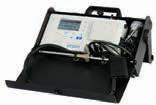










Singapore’s one-stop farm-to-table solution for food traceability and data analytics, The GrowHub Innovations Company announced its strategic partnership with ManukaLife, Western Australia’s high-grade manuka plantation developer and producer of premium-grade manuka products.

The GrowHub will be ManukaLife’s appointed distributor for some of its premium-grade manuka honey, royal jelly, and oil products in Southeast Asia and China. Shoppers will now be able to purchase ManukaLife’s famed Manuka honey, Royal Jelly and Propolis sachets, and Medicated Throat Spray.
Other products will be available on The GrowHub partner retail channels in Singapore, Indonesia, Malaysia, and China as well as from its own eCommerce shop. To support the distribution of its

products, The GrowHub will provide ManukaLife with its Web-3 technology framework that enables traceability and authentication of its products using machine learning and artificial intelligence which automatically detects imitations and suspicious behaviour.
Stakeholders from origin to destination can easily trace the history of the product along the supply chain and validate its authenticity.

In addition to this, The GrowHub will also provide ManukaLife customer analytics to understand the reception of its products in the markets.
Through data available via The GrowHub, ManukaLife will be able to gain a better understanding of the perception of the product by consumers, identify optimal product pricing, and generate other key insights that will help
them better market their products to customers in the region.
“We have always placed our focus in the Southeast Asia and North Asia region,” said Lester Chan, CEO of the GrowHub Innovations Company.
“This partnership with ManukaLife has given us the opportunity to look beyond traceability, minimising chances of product counterfeiting to protect brands and build trust and confidence among our consumers.” F

NEWS www.foodmag.com.au | December 2022 | Food &Beverage Industry News 11
INSTRUMENTATION & CALIBRATION PTY LTD SPECIALISTS AMS have been suppliers of instrumentation and calibration equipment to all industries since 1973 representing some of the world’s leading manufacturers of the equipment in their field. www.ams-ic.com.au The Liquid Measurement Experts Dew-Point, Humidity and Oxygen Specialists Analytical Process Division www.ams-ic.com.au sales@ams-ic.com.au Leaders of Inline Process Control Solutions Gas Analysis Combustion Gas Analysis
The GrowHub will also provide ManukaLife customer analytics to understand the reception of its products
Chobani generates half a million meals for Australians
Victoria-based food brand Chobani’s Fruit for Good yogurt collaboration with Foodbank has recently come to an end, generating half a million meals for Australians facing food insecurity.
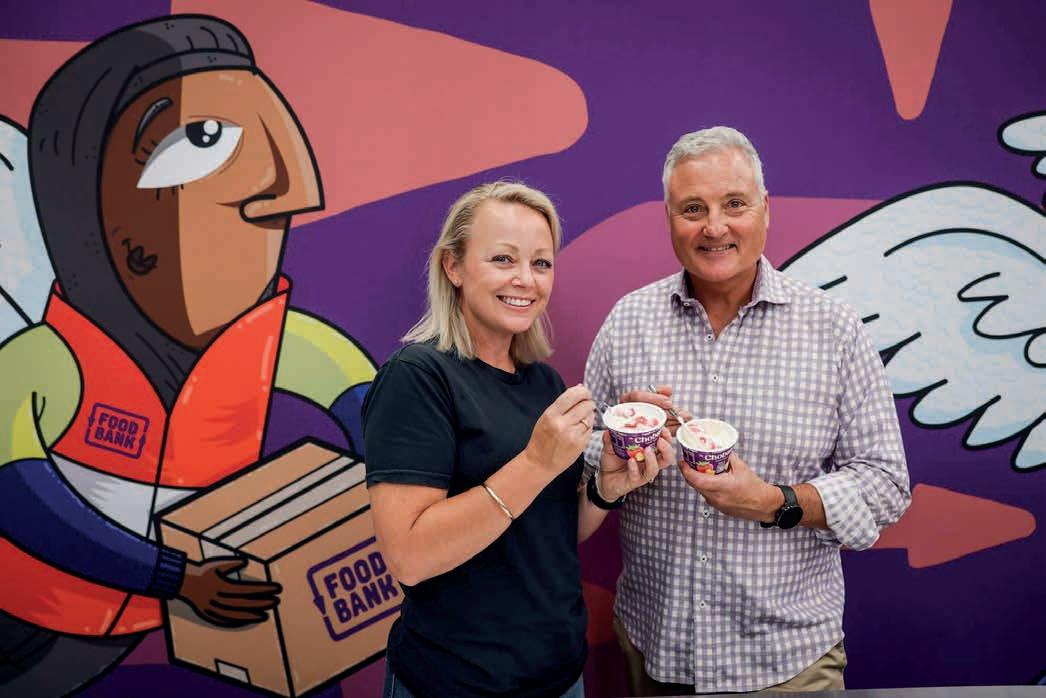
In February Chobani collaborated with Foodbank to create a categoryfirst yogurt with 100 per cent of profits donated to the charity.
Available in Coles, Woolworths and independent retailers, the 170g pot Fruit for Good was a fruit salad flavoured yogurt with a blend of pineapple, strawberry, watermelon and apple.
Across its entire supply chain, Chobani’s suppliers and retail partners supported Fruit for Good, donating either partial or 100 per cent of their profits to increase the initiative’s impact on Foodbank.
Chobani Australia general manager ESG and general counsel Tim Browne said he was thrilled with the initiative’s impact.
“Our long-standing partnership with Foodbank is one we’re extremely proud of. Having already donated the equivalent of more than one million meals through dedicated regular yogurt donations over the last ten years, Fruit for Good was a way of challenging our own norms.
“We created a product we knew our Chobani consumers would love, whilst allowing them to do good simply by doing the weekly grocery shop. The combined impact with our retail and
supplier partner contributions was significant, and we’re proud to say together we’re donating the equivalent of 552,000 meals to Foodbank.”
Foodbank’s tenth annual Hunger
Champion Flour Milling announces new leader

New Zealand-based flour miller Champion has announced that Chris Anderson will be its new director and country manager for New Zealand.
The appointment was suggested by sibling company Allied Pinnacle Chief Executive David Pitt and Managing Director Takao Ouchi to leverage the legacy and combined strength of the two leading Australian and New Zealand flour milling businesses.
Both companies are owned by parent company Japan’s Nisshin Seifun Group Inc., which approved the new director’s appointment as Champion’s shareholder.
Anderson has over 20 years of FMCG experience across a broad range of sectors and categories, having held senior commercial roles with Coca Cola Amatil, Streets Ice Cream, SC Johnson and Goodman Fielder.
Most recently Anderson held the role of merchandise manager for Foodstuffs
North Island, with multiple category responsibilities including Bakery, Chilled, Alcohol, Deli, Eggs, and Beverages.
In July 2020, Anderson led FoodStuffs to partner with Fonterra to produce Simply Milk, New Zealand’s first carbon-neutral milk. The milk, created in response to consumer demand allows conscious Kiwis to reduce their carbon footprint through purchase.
Allied Pinnacle CEO David Pitt, said he is thrilled to have the highly
Report revealed that natural disasters can be what kicks off the cycle of food insecurity, with 19 per cent saying natural disasters were a reason they couldn’t meet their household’s food needs. F
accomplished FMCG professional join the executive team.
“Chris has a proven track record of finding customer-centric solutions and as we continue to shift gear from strategy to execution, he will lead the team to drive value and win in our chosen categories. Across both markets, we have a clear vision – to be the Flour, Bakery Ingredients and Frozen Baked Goods business partner of choice in both Australia and New Zealand.” F
NEWS 12 Food &Beverage Industry News | December 2022 | www.foodmag.com.au
Foodbank’s tenth annual Hunger Report revealed that natural disasters can be what kicks off the cycle of food insecurity.
Coles Group to launch SECOS MyEcoBag
Coles Group will be launching MyEcoBag compostable bag products by SECOS in 770 retail stores across Australia.
The selection by Coles follows a recent range review involving SECOS’ compostable products and is on the back of significant sales growth year on year for MyEcoBag in Woolworths stores.
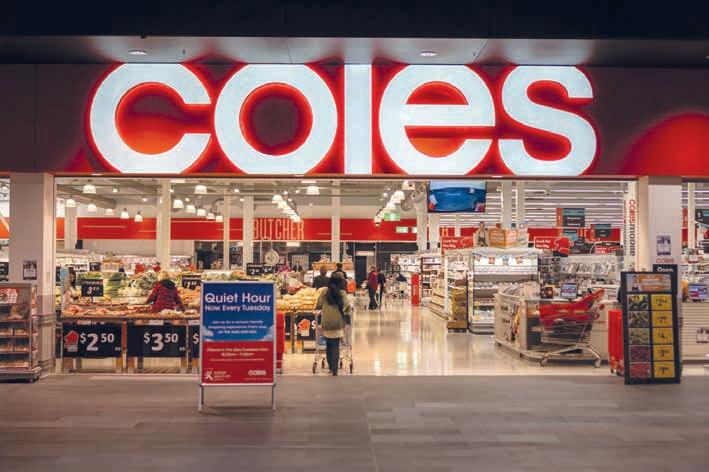
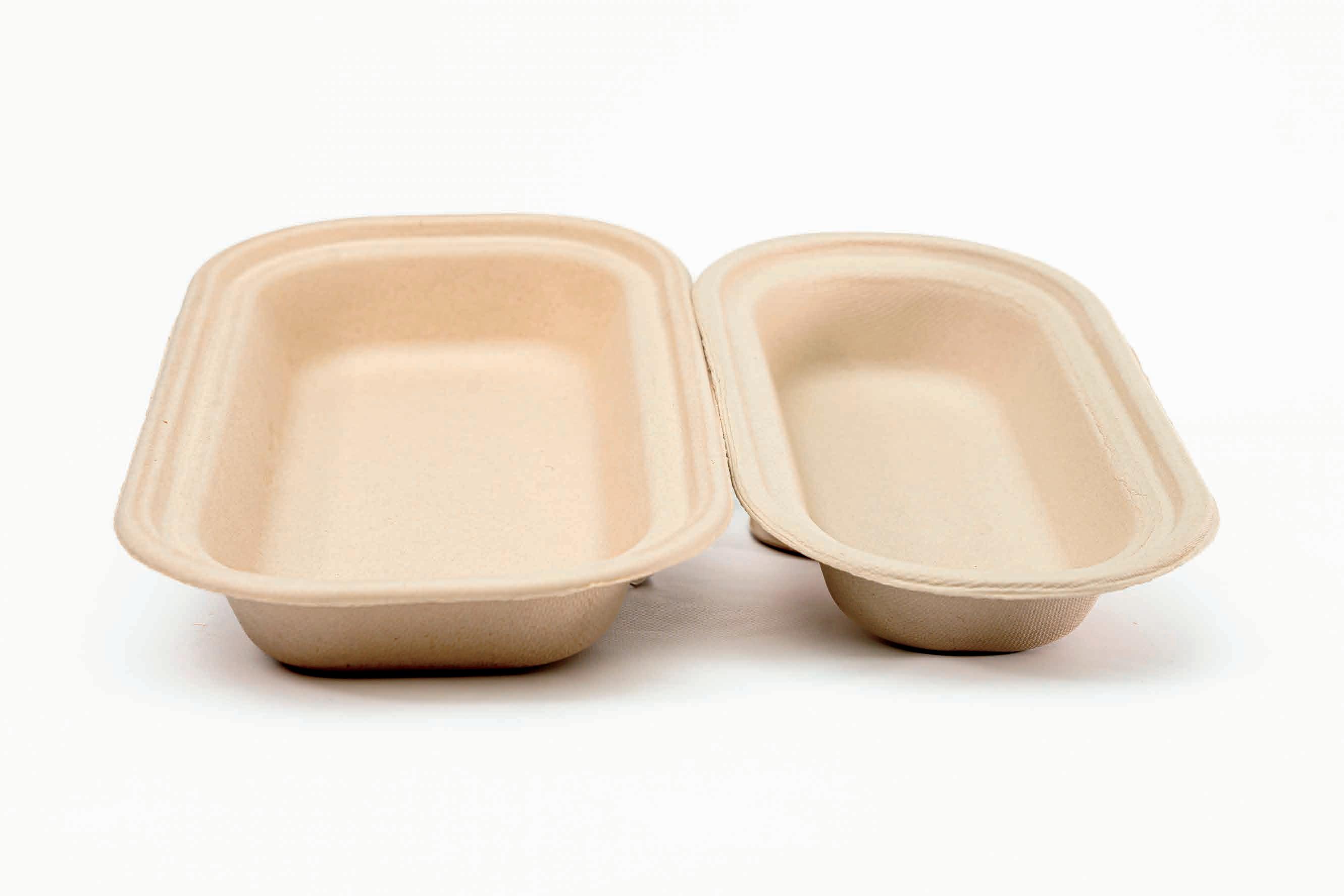
SECOS Group develops and manufactures sustainable packaging materials, supplying its proprietary biodegradable and compostable resins, packaging products and high-quality cast films to a blue-chip global customer base.
For Coles, SECOS will launch a new shelf-ready presentation pack of the well-received 36L pack and a new 27L pack. Both packs are ideal for kitchen food and garden waste diversion to green bins FOGO programs, providing a fully compostable solution.
In Australia, the wider availability of SECOS’ compostable bags via Coles stores will give more households participating in approved council food organic waste programs the option to dispose of the bags and food waste in their green waste bin.
The use of SECOS’ compostable bags offers households a clean and convenient way to assist with the separation of their

food waste which is critical to ensure food does not end up in landfills.
Coles has added the two MyEcoBag SKUs on a non-trial basis, which will be distributed nationally. The ongoing supply of the two MyEcoBag SKUs will be subject to meeting sales projections as part of the annual range review.
The significant growth in MyEcoBag sales in Woolworths and now Coles will take the MyEco branded products to over 2,000 retail stores in Australia. This store footprint plus SECOS’ Australian-wide distribution network, which supplies a select range of independent stores gives the company a significant retail reach.
SECOS has said it continues to develop further opportunities for growth in new markets for its branded MyEcoBag and MyEcoPet line of products and is working to garner market share in grocery and convenience stores in Australia, the USA, Latin America, and elsewhere.
The increased sales of the MyEco range in Australia is supported by SECOS’ recent manufacturing capacity expansion in the group’s new Malaysian biopolymer plant which commenced production in the March 2022 quarter with capacity to support annual sales of $25 million. F

www.foodmag.com.au | December 2022 | Food &Beverage Industry News 13 Place a sustainable future in the hands of consumers AUSTRALIAN-MADE COMPOSTABLE PACKAGING TO GAIN EXCLUSIVE ACCESS AND TO BE NOTIFIED OF OUR SAMPLE AVAILABILITY, SIMPLY SCAN THE QR CODE AND REGISTER RIGHT AWAY. FOOD | FRESH PRODUCE | MEAT PACKAGING sales@copar.eco WWW.COPAR.ECO+61255656770 NEWS
Coles Group will be launching MyEcoBag compostable bag products by SECOS in 770 retail stores.
FSAA announces board ahead of 2023
With another successful year for the Foodservice Suppliers Association Australia (FSAA) rapidly drawing to a close, the organisation’s Annual General Meeting has again taken place in Sydney last week.

Not only a time to reflect on progress, and to plan for the year ahead, the AGM facilitates the important process of electing and establishing the organisation’s Board.
Board members play an integral role in ensuring the continuation of a focus on providing opportunities for FSAA members through networking, education and professional development.
New Board members include Kristina Czepl of Nestle Professional
who is taking over the reign from Scott Stuckman.
The FSAA said it is delighted to welcome back Jeff Dhu of Anchor Food Professionals, as director, re-joining the Board after a hiatus. The FSAA added that it is privileged to be able to tap into his 37 plus years of experience within foodservice, his leadership and the respect he garners from the industry as an innovator and forward thinker.
Collectively the Board has more than 339 years in the foodservice industry, creating a solid foundation of insight and experience to ensure the FSAA continues to add value, continues to take the organisation forward and continues to focus on what is most pressing and important for its members.
The full list of Board Members of the FSAA for 2023 is as follows:
Office Bearers
Chairperson – Ken Hartley, Priestley’s Gourmet Delights
Vice Chairperson – Andrew Low, Ordermentum
Treasurer – Lindsay Yeomans, The Armory
Secretary & CEO – Minnie Constan
Directors
Jeff Dhu, Anchor Food Professionals
Yezdi Daruwalla, Unilever Food Solutions
Kristina Czepl, Nestle Professional
Barton Beverley-Smith, Primo Foods
Donna Cox, noumi
Wayne Viles, Unox Australia
Eugene Visione, Birch & Waite
David White, DKSH
Tony Nay, Incremental Marketing. F
Closing the loop on soft plastic packaging with new recycling trials
Australia’s food and grocery manufacturers are backing a new scheme aimed at keeping soft plastic packaging out of the landfill and helping to build a new recycling industry producing sought-after food-grade, recycled soft plastic packaging.
Coinciding with National Recycling Week, the first in a series of trials of kerbside collection of soft plastic
recycling of plastics such as bread bags, cereal box liners and ice cream wrappers easy for participating households.
The trials are part of the National Plastics Recycling Scheme project (NPRS), which is led by the Australian Food and Grocery Council (AFGC) and will help design a model for large-scale “bag-in-bin” kerbside collection and sorting of soft plastic packaging for advanced recycling.
About 487,000 tonnes of soft plastic
packaging was used by businesses and homes in Australia in 2019-20 with just four percent of that material recycled.

Diverting soft plastics from landfill will provide a clean stream of material for Australia’s emerging advanced recycling industry.
Plastics from the Macedon Ranges Shire Council trial will be taken for advanced recycling to APR Plastics in Dandenong, Victoria.
In advanced recycling, the material
is converted into oil that can be used to make new plastics.
Seventeen major food and grocery manufacturing companies have signed on as Foundation Supporters of the NPRS project, committing funds to the trials and pilots.
Food and grocery manufacturing is a $133.6 billion industry in Australia that employs more than 272,000 people, and sustainable packaging is a key focus for ensuring a sustainable future . F
About 487,000 tonnes of soft plastic packaging was used by businesses and homes in Australia in 2019-20.
NEWS
Foodbank Australia calls for urgent food donation tax reform
Despite clear environmental, social and economic benefits of donating food to food relief, Australia’s current tax framework does not motivate food producers to donate excess stock.
In fact, in tax terms, donating is no different to recycling or sending to landfill even though it may cost the company more.
Australia currently wastes over 7.6 million tonnes of food each year costing the economy over $36.6 billion. Of this, 70 percent is perfectly edible and redirecting it to food relief would potentially deliver a social return of $2 billion at a time when the demand for food relief has never been higher.
Foodbank is recommending that Australia’s tax settings be recalibrated to incentivise donations to food relief.

Experience in other countries, including the USA, France, Canada and the Netherlands, shows that tax incentives are the most effective way to increase the redirection of food donations to food relief.
The tax incentive proposal, developed by KPMG Australia with the support of the Fight Food Waste Cooperative Research Centre and Australia’s food relief sector recommends a two- tiered tax incentive based on the ability to offset a percentage of costs related to food donations from taxable income.
Its aim is to encourage food producers to donate surplus product to food relief rather than sending it to landfill.
KPMG has now completed a follow-up project where it consulted widely with the food industry to determine the feasibility and potential effectiveness of the proposed tax incentive.
Interviews were conducted with 33 companies representing both national
and local businesses along the whole food supply chain. The overwhelming message is that there is whole-of-sector support for the scheme. In fact, companies are highly passionate about the potential of the incentive to really shift the dial on redirecting surplus to food relief.
Fonterra appoints new chief financial officer

The Fonterra Co-operative Group announced the appointment of Neil Beaumont to the role of chief financial officer, effective early February 2023.
Beaumont is an accomplished Group CFO, experienced in operating at the most senior levels of global and in complex business environments.
Most recently he was senior managing director, chief financial and risk officer at Canada Pension Plan Investment Board (CPPIB), with responsibility for leading the operations, finance and risk functions for the CAD $500 bn investment fund.
“We’re delighted to welcome Neil to the team. He’s an experienced global
finance leader whose expertise in strategic implementation will be a real asset to our management team,” said Fonterra CEO Miles Hurrell.
Beaumont has held senior roles at BHP Billiton in Chile and Australia and at KPMG. He is a Chartered Accountant with the Canadian Institute of Chartered Accountants and holds
The Foodbank Hunger Report 2022 highlighted that over 2 million Australian households were severely food insecure in the last 12 months and on any given day 306,000 households are receiving assistance from food relief organisations. F
University of Saskatchewan.
Hurrell thanked the acting CFO Chris Rowe for his contribution covering the position following the resignation of previous CFO Marc Rivers. Chris will continue in the acting role until Neil joins the Co-op early next year. F
NEWS www.foodmag.com.au | December 2022 | Food &Beverage Industry News 15
Over 2 million Australian households are severely food insecure.
ALDI statement on NSW singleuse plastic ban expansion
In a statement, ALDI Australia has said it understands the environmental impact of single-use plastics and has taken multiple steps over the years to take responsibility for any potential impact.
The statement followed New South Wales’ ban on single-use plastic items, which has been expanded from 1st November to include single-use plastic straws, stirrers, cutlery, plates, unlidded bowls, cotton buds, as well as foodware and cups made from expanded polystyrene foam (EPS).
Reaffirming ALDI commitment to plastic waste reduction and the steps that they have taken to reduce their impact, Daniel Baker, corporate responsibility director for ALDI Australia said, “Finding sustainable alternatives for packaging has always been important to us at ALDI. With our strong focus on tackling plastics, we are supportive of
the Meeting of Environment Ministers to work with the private sector to reduce waste.
“We agree the business plays a critical role in developing a circular economy and in turn, reducing plastic waste, ALDI has a commitment to a 25 per cent reduction of plastic packaging by 2025, and we are well on our way to achieving this.”

“ALDI recognises the negative environmental impact of single-use plastics, which is precisely why we’ve never provided free-of-charge plastic carrier bags and made the decision to remove all single-use plastic tableware from our shelves in 2020,” explained Baker.
“We were the first major Australian supermarket to replace plastic straws with paper straws on juice boxes. The roadmap also identifies the negative impact of microbeads, which ALDI
stamped out across our cosmetics, personal care, detergents, and cleaning ranges in 2018.
“Preventing plastics waste from entering the Australian environment is
ALDI was the first major supermarket in Australia to replace plastic straws.
essential, and ALDI is excited to continue stepping up and take responsibility for our impact. We welcome and encourage others in the industry to join the fight alongside us.” F
Victorian Government highlights food manufacturing priorities
The Victorian Government recently announced its vision for the future of the state’s manufacturing industry, for the first time highlighting alternative proteins as a priority sector within food manufacturing.
Victorian minister for Industry Support and Recovery Ben Carroll launched the Made in Victoria 2030: Manufacturing Statement, which outlines the Government’s ongoing plans for the state’s $31 billion manufacturing industry.
It was noted that the agrifood sector still has room for significant innovation and growth.
Victoria’s $36.9 billion food manufacturing sector accounts for a third of the state’s manufacturing output. It exports over $9 billion in manufactured food and beverage products annually and employs more than 74,000 people.
Within the food manufacturing sector, the statement included the following strategic priorities:
• Advanced food manufacturing capability and food innovation
• Growing Victoria’s sustainable food manufacturing capability
• New high-growth sectors and valueadd opportunities
• Developing Melbourne’s north as a centre for Victoria’s world-class food innovation and value-adding ecosystem
The statement also highlighted Victoria’s achievements in the food manufacturing sector:
• S VG Thrive agrifood accelerator located in Melbourne
• $133 million investment by George Weston Foods in facilities across regional Victoria
• $12 million investment in alternative protein innovation at the Grains Innovation Park in Horsham

• $10 million investment in Morwell Food Manufacturing Precinct
• Food Frontier inaugural alternative protein conference in Melbourne
• Delivery of the Australian Food Innovation Centre business case
Within the new policy statement, the Victorian Government noted that the already strong agrifood sector still has room for significant innovation and growth, pointing to the work of existing R&D centres such as AgriBio research centre at La Trobe University and the National Food Innovation Centre at CSIRO in Werribee. F
NEWS 16 Food &Beverage Industry News | December 2022 | www.foodmag.com.au

internationalcoffeeexpo@primecreative.com.au Melbourne Convention and Exhibition Centre www.internationalcoffeeexpo.com Melbourne International Coffee Expo 2023 PACKAGING TECHNOLOGY CELEBRATING 10 YEARS OF EVERYTHING COFFEE Celebrating 10 years of MICE and everything coffee Equipment Roasters Production Packaging 17—19 August 2023 Book your stand to take part in the Southern Hemisphere’s largest dedicated coffee trade show.
How small brewer found success and growth in competitive market
Bondi Brewing Co got its humble beginnings in a Bondi Beach garage but today the manufacturer is on major retail shelves and across the hospitality industry. Adam McCleery writes.
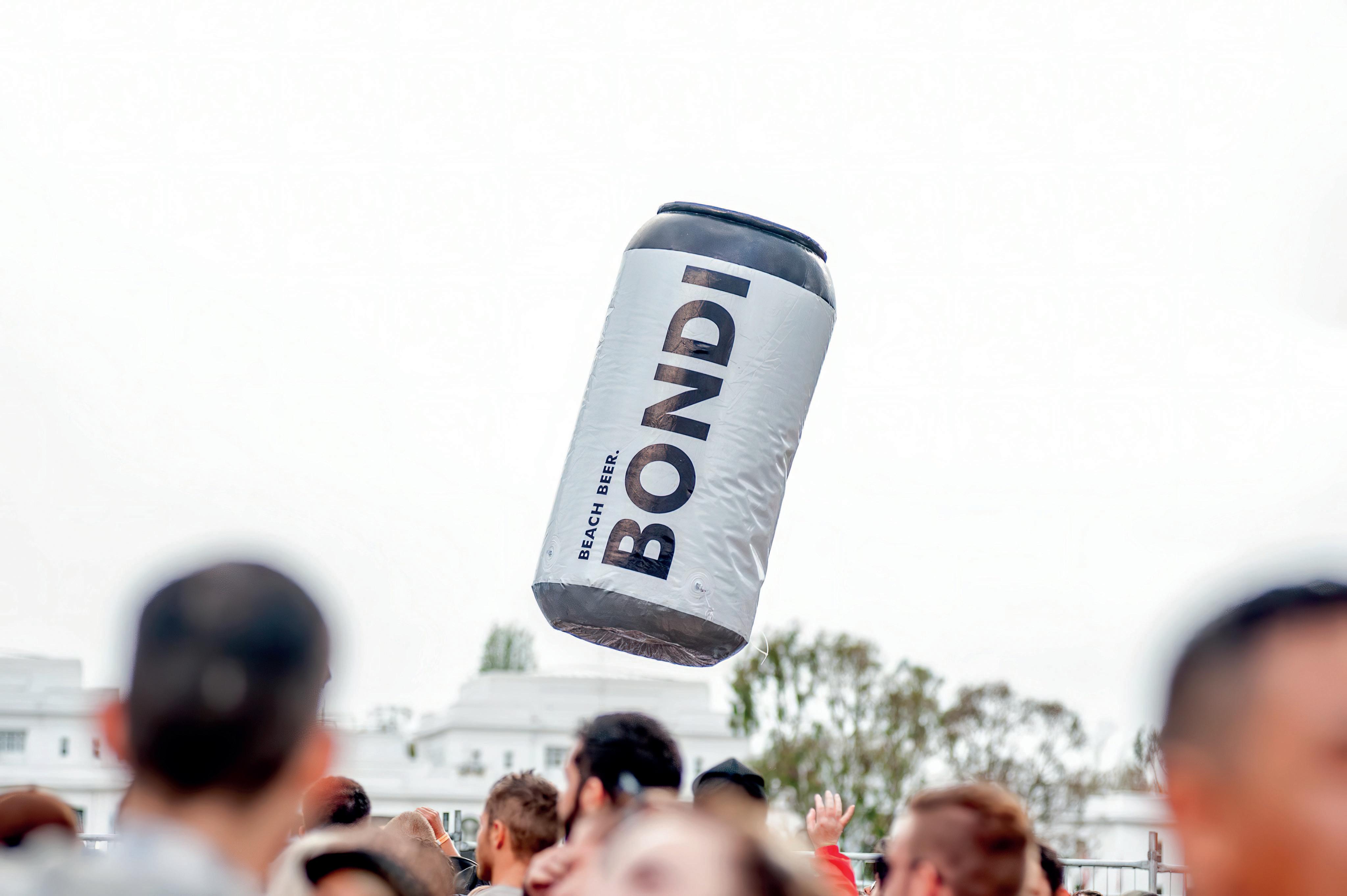
MEET THE MANUFACTURER 18 Food&Beverage Industry News | December 2022 | www.foodmag.com.au
Bondi Brewing Co. was founded in the Eastern Suburbs of Sydney and continues to grow in popularity.
When Bondi Brewing Co founder Paul Parks started brewing beer as a hobby, he never expected that within a handful of years the company would be upscaling to meet consumer demand, let alone be selling his beer.
“We started in a garage, but we first approached local bars and restaurants and we really got that support behind us and without that I think it would have been impossible because we are up against 400 other brands out there which makes it hard to get the volume up quickly and get those commercials in the right space to keep you going,” said Parks.
Parks had already made beer brewing a long-time hobby before the idea to go commercial every struck him.
“I’ve been brewing beer for quite some time for friends and family, it started as a hobby, but I teamed up with Brendan McKenna and he has a good business head on him,” he said.
“He encouraged me to make something more out of the hobby and he helped me structure it right, set up the company and get the license. From there we went out to market and started brewing beer commercially.”
Bondi Brewing Co beer can now be

found in hospitality establishments and retail outlets but Parks said the growth happened organically and off the back of listening to his customers.
“I started with the kits from the supermarket when I started. I worked on one particular beer more than the others and that was just a pale ale which I kept tweaking based on feedback,” he said.
This philosophy remains at the heart of how Bondi Brewing Co decide what products to push, and which ones might not be doing so well, which in time has borne fruit for the company.
“We were messing around with ingredients and quantities until we came across a recipe that everyone said would be a success. It was called Beach Beer Bondi and that was our first product,” said Parks.
“It was a more hoppy beer but if you describe it to a non-beer drinker you would call it fruity flavoured. We released that beer in 2018.”
Recognising the growth of the craft beer market, and at the right time, was another pillar in Bondi Brewing Co’s early success.

“If we follow trends from over in the USA, over the last 15 to 20 years the consumer market has moved dramatically over to craft beer,” said Parks.
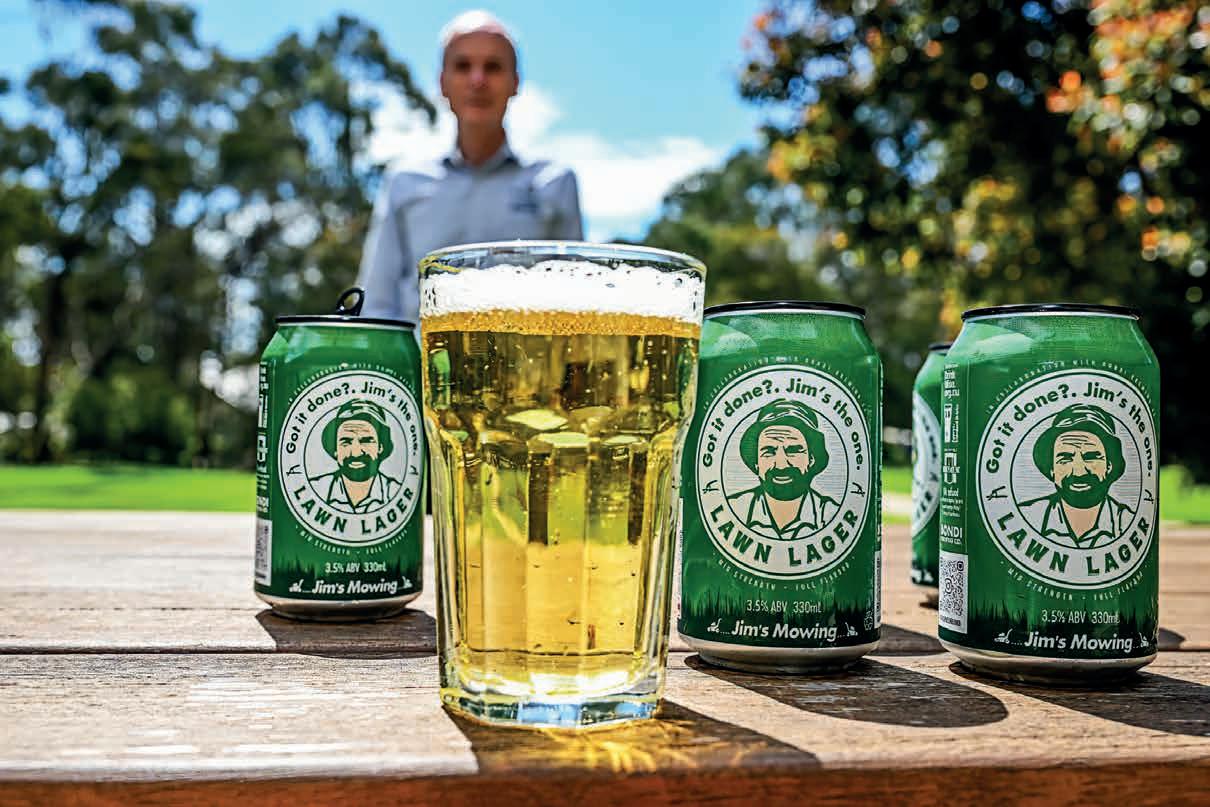
“Now you can feel fancy when talking about the latest craft beer that’s out there.”
Local support was also a critical part of keeping Bondi Brewing Co alive in the early days, and for its growth.
“We were also lucky to get in the Bondi BWS, and through investigation we found the right person to talk to and put our pitch together before speaking to the team leaders for the local beer department in Woolworths,” said Parks.
“They were great, they helped coach us along and helped us grow.
“All our products are approachable and easy to drink, our mantra is ‘the beer for drinking’ so we make beers we want to drink. With that in mind we developed a dryer and less sweet product.
“That was our angle and our point of difference and again that was well received.”
And it was this strong local support which also helped Parks maintain good cash flow while slowly expanding the business into what it’s becoming today.
“We are a local brand from the area so when we first started the business, we had a different name more synonymous with a specific area of Bondi, the first beer we brought out we designed the labelling ourselves and we gave them a simple design to look like a coffee cup,” he added.
“Then we stuck Bondi on the side and people started to refer to us as the ‘Bondi beer’, so we ran with that and decided to own it.”
“Listening to the consumer definitely plays a part with our growth and how
www.foodmag.com.au | December 2022 | Food &Beverage Industry News 19
MEET THE MANUFACTURER
The Bondi Brewing Co. has partnered with Jim’s Mowing as part of its strategy to collaborate with interesting brands.
Strong community support for Bondi Brewing Co. helped the brand gain traction in the market.
"We had the idea while chatting and we wanted something to be truly Australian and a Jim’s mowing van came along and we just knew that was the one."

successful it was around the Bondi area because people want to support local and

else and being our main market, we investigated the idea.”

That same 2018 summer was when Parks was first confident that they were onto a winning brand, especially after brokering deals with national companies.
“The summer of 2018, with the volume we sold and seeing our merchandise spreading, gave us confidence that we have a brand that
Co. has been following consumer trends and giving people what they want.
A key to the success of
MEET THE MANUFACTURER
Jim’s Lager is the brain child of the Bondi Brewing Co. and Jim’s Group.
Bondi Brewing

LIQUIDE premium gases keeping your produce as fresh as the day you harvested
AIR
ESSENTIAL SMALL MOLECULES FOR MATTER
Discover How. Air Liquide’s +50 years expertise and experience in the food industry could elevate your produce.
It’s vital that decision makers look towards supporting efficiency centric automation.
A rock-solid gateway to eliminating machine failures
In a market contending with labour shortages and increasing cost of production, it’s vital that key decision makers look towards supporting efficiency-centric automation frameworks.
Industrial innovator Schaeffler is combating these challenges head-on with their Lifetime Solutions portfolio. Ben Kang, manager for this suite at Schaeffler Australia, explains that the offering can be categorised into three parts – predicative maintenance, smart maintenance tools, and lubrication.
The first of these encompasses the brand’s plug-and-play condition monitoring tool, OPTIME, which facilitates anomaly detection and AI diagnostics in the cloud.
The OPTIME software environment can be integrated into commonly used systems such as PI Historian, SCATA, and SAP via REST API, and is accessible through a user-friendly web or smartphone interface.
Compatible with most machines,
it works to detect bearing damage, lubrication related issues, imbalance, and misalignment before breakdown calls for costly unplanned downtime and consequential damage to the asset.
The second category – smart maintenance tools – covers a selection of modern equipment that helps to look after componentry, such as alignment tools, induction heating devices, and hydraulic equipment.
“These are widely used by large food and beverage manufacturers around the world, often in tandem with the available product training and localised support,” said Kang.
“The key drawcard is its universal standardisation – if a company has one plant in France, and another in Australia, they can rest assured that the technology will work the same and the support is available everywhere.”
The third category in the Lifetime Solutions suite is smart lubrication portfolio. From high performance greases designed to ensure high
bearing performance, to remote connected, lubricating devices such as OPTIME-C1, this range can be implemented to provide extended operating life, combat labour costs, or provide visibility on points that are difficult to monitor manually.
“These singular units are connected through the OPTIME mesh network,” said Kang.
“Users can – from the dashboard application – visibly track things like lubricant fill quality, days remaining on each grease cartridge, and battery life.
“For an industry like food and beverage, where you’ve got a lot of smaller machines spread out in a plant, keeping on top of each and every lubricator can be quite challenging. So having all this information on display is a game changer.”
The OPTIME mesh network allows a single site to deploy many points within a robust digital infrastructure. Each point, whether it is a smart lubricator or vibration sensor, will ‘talk’
to each other, allowing one gateway to service a wider area via a robust mesh network. It is also self-repairing, to accommodate for when one unit exits the mesh during equipment service or relocation.
“This is an important point to consider when choosing a remote monitoring solution,” Kang explained.
“The first thing people ask is whether the communications are reliable between each node in the network, and what we’ve seen with OPTIME as it’s been deployed in the field is its connectivity is rock-solid. Features like the battery life and data collection capabilities are world-leading for this type of technology.”
When it comes to food and beverage operations, compliance is king.

Depending on the type of site, each piece of equipment will need to meet specific and stringent standards – and these will likely require constant monitoring.
In answer to this, Schaeffler has honed solutions such as an OPTIME
22 Food &Beverage Industry News | December 2022 | www.foodmag.com.au MACHINERY
The food and beverage industry consists of countless moving parts, and closely monitoring each point of potential failure is both costly and time-consuming, Food & Beverage Industry News reports.
sensor designed for explosive environments, and monitoring tools for applications like oil pumps, grain handling equipment, and open conveyor systems.
“Because of industry-specific requirements and food safety laws, it’s important that operators can keep a close eye on whatever’s being processed on site,” Kang continued.




“If one of our sensors can flag an issue on a small section of a conveyor line, that could potentially prevent contamination and total batch recall which would cost the user significantly – financially and reputation-wise.”
The move towards automation and digital environment processing is happening at a rapid pace, and according to Kang, those who fail to uptake new technologies such as remote condition monitoring will likely

www.foodmag.com.au | December 2022 | Food &Beverage Industry News 23 MACHINERY
State of the art food production and storage facility Temperature controlled throughout Total size 8,200sqm* Fully drive around Accessed from on-grade and recessed docks *approx. Michael O’Neill 0431 500 939 michael.oneill@cbre.com.au Shaun Timbrell 0433 302 979 shaun.timbrell@cbre.com.au Rajal Chaudhary 0413 485 456 rajal.chaudhary@cbre.com.au Contact the exclusive leasing agents for more information or to arrange a tour: 7-9 George Young Street, Auburn, NSW 2144 For Lease Schaeffler Lifetime Solutions can eliminate up to 100 per cent of machine failures.
Wheat straw gains in popularity
COPAR is experiencing first-hand the growing popularity of wheat straw as a viable option for an alternative packaging source, both locally and abroad. Food & Beverage Industry News reports.

With the announcement that Australia would be phasing out single use plastics permanently, the search for viable alternatives has kicked up a gear for the food and beverage industry.
Recently, REDCycle’s soft plastic recycling program, whereby consumers dropped off their soft plastics at Coles and Woolworths, temporarily suspended its collection. Although REDCycle planned to scale their recycling, they could not keep up with the rapidly growing soft items collected and resorted to stockpiling it in warehouses. This practice is both an environmental and safety risk and lead to the suspension of the program in November 2022. This highlights the inherent difficulties into relying strongly on recycling plastic as a solution for the plastic pollution crisis. Further, this erodes consumer confidence in recycling, particularly current packaging that still contains the REDCycle disposal instructions. Other alternatives that focus on compostable products for packaging materials are viable options. Other packaging options that consist of compostable materials should also be utilised to achieve extended producer responsibility and a circular economy
With the time given for businesses
to transition away from plastics many have started to inquire with developers, manufacturers, and suppliers of alternative packaging such as paper and hemp.
However, a new option is quickly gaining traction overseas and here in Australia for its long list of advantages which include easy turnaround, local supply, being compostable, and being capable of creating a circular economy around it, and that is wheat straw.
COPAR, specialists in sustainable packaging solutions, have been researching and developing wheat straw pulp, in partnership with the University of Newcastle and other interested stakeholders, as a viable fibre-based packaging option.
“The interest in wheat straw has really grown, particularly overseas,” said COPAR business development manager, Colin Farrell.
“We attended the London Packaging Week Trade Show in September 2022, after meeting with major packaging distributors and other technology partners in Manchester. They showed strong interest in the wheat straw option.
“We got over 200 leads at that trade show. The demand for pulp-based packaging over there is probably more advanced than here in Australia. This is because they have more penalties
in relation to using virgin plastic in packaging.”
Farrell said he observed that the United Kingdom has taken a more concerted approach with consumer waste management, particularly composting as high value recycled organic material, and appeared to be a key driver behind the interest in wheat straw fibre-based packaging.
“For example, in England they have multiple recycling and waste bins, with general waste only needed to be collected once a month, if the consumer divides up the waste and recycling items correctly,” added Farrell.
“I was told that when this was introduced, many people thought was it wasn’t going to work, but it has proven to be a success.
“Most of Australia still adopts a recycling bin and waste bin only. It goes to show we have some catching up to do from a consumer perspective and I think compostable products are a great option for that.
“Ideally, we would love to see this fibre-based product go into some type of organics or compost bin, because it’s made from wheat straw, and it can break down there. Of course, we need to see an expansion of composting bins for that to become a reality.”
And with the government ban
on plastics being made official, compostable/recyclable packaging is more important than ever.
Paper-based packaging has also started to see a return to popularity, although more innovative than those offered in the past. But Farrell said the industry can’t afford to run the risk of relying heavily on one form of alternative packaging again, as with plastic.
“We are keen to collaborate with local councils to conduct case studies in terms of waste management.”
“We may see in the near future why plastics ended up being the option most businesses stuck with for so long,” said Farrell.
“We can’t put all our eggs in one basket in terms of alternative packaging, and in this case that would be paper packaging and using recycled plastics.”
The environmental impact of increasing the use of paper-based packaging was another area of concern for Farrell.
“We have to cut down trees to make paper, you can reuse paper, some paper can be composted, but recycling has the added process to break it down to prepare for recycling,” he said.
“Whilst with composting we can use wheat straw as an alternative. And you can keep that circular economy with wheat straw.
PACKAGING 24 Food&Beverage Industry News | December 2022 | www.foodmag.com.au
Wheat straw as an alternative packaging solution was a hit at a London trade show.
This is because until recently, the wheat straw off cuts we use has been treated as a waste by-product of the agricultural industry, however the wheat pulp has proven to be a great foundation for packaging.

On top of this, it is cheap, in abundance in Australia, has a rapid turnaround time and perhaps most importantly, it creates a new revenue stream for Australian farmers.
“It’s also quicker to grow and easier
plastic in the first place will become more apparent as we move away from it. Plastic is a very flexible and cheap product that suits many packaging requirements – it is now, however, increasingly harmful to the environment upon disposal”
Being able to source all the required materials for wheat straw packaging in Australia also cuts down on supply chain times and mitigates the risk of major disruptions.
“When you get your materials locally you have full control of the supply chain, and it also gives farmers extra revenue because wheat straw we use was always discarded as waste. We are using that waste to provide our farmers with an additional source of income.,” said COPAR marketing specialist, Fathima Sameer.
“Suppliers who want to buy from us will want to know where their products come from, who has manufactured and supplied it.
“In our case we have everything happening in Australia and that’s something that is evident in the trade show, even though we are form Australia they were interested in Australian made products because they have the ability to track the supply chain.”
COPAR also boasts the ability to tailor make products for the market.
“Being a manufacturer ourselves we can cater to multiple industries which means we have the ability to customise the product to what the business and consumers want,” said Sameer.
For Farrell, the provenance of their product is also of extreme importance.
“Overseas they also want to know the quality of the wheat straw, where it’s sourced,” he said.
“Those issues are becoming more apparent, consumer demand is one driving force behind that, wanting to know where the packaging is coming from and how it’s made.
“Wheat straw is a new product, and we should be proud in Australia to be jumping onto it. For Australia it is a great solution in terms of wheat straw being the right product.”
A critical step to seeing wheat straw
packaging take off is being able to accredit Australian sourced and made wheat straw for global consumption.
COPAR has partnered with the University of Newcastle to achieve this very goal.
“We have a research arrangement with the university of Newcastle which we started in 2021,” said Farrell.
“Australia, to its credit, has a higher standard than the rest of the world for testing bio-packaging products, as it must pass an earthworm toxicity test, to ensure a consistently high quality, high value compost that is good for the environment.
“Australia doesn’t have any internationally recognised certification service, so the University of Newcastle is working to develop one.
“They are undergoing that process to get the certification to be able to do that on Australian products. We aren’t sure on the time frame, but it should be soon.”
And in terms of interest in Australia already, Farrell said the company has over 300 current leads regarding the development of wheat straw packaging.
“When the certification centre is opened, testing can be done more cheaply and at our back door which speeds up the supply chain,” added Farrell.
“And our products will have that testing and certification with the University of Newcastle to international standards which will open up wider markets.”
It’s an exciting time in the alternative packaging space and the message from COPAR is to diversify the market options. F Wheat straw is gaining popularity as a packaging alternative.

PACKAGING www.foodmag.com.au | December 2022 | Food&Beverage Industry News 25
Food and beverage trends: Sights set on sustainability
As sustainability targets get ever closer, SMC Corporation Australia New Zealand continues to guide companies towards reaching and exceeding them. Food & Beverage Industry News reports.

With a firm focus on sustainable development goals, SMC Corporation Australia New Zealand works with customers who set bold energy efficiency targets, and achieving these is paramount.

“We deal with customers with similar targets and objectives to our own,” explains Paul Grantham, global accounts manager – End User Lead ANZ for SMC.
“We understand that there is the need to obtain these targets and then there is the realisation of ‘but how do we make this happen?
“Customers are looking at their sustainability targets and trying to figure out how this translates into operational efficiency.
“Many of our customers are multisite, multi-state companies, and rolling this out across the various sites and operations can prove challenging.”
Take a dairy company for example, said Grantham. One site may be
“It is rarely simple as the different sites will have different challenges and also possibly different targets based on what they manufacture,” he said.
This is where SMC comes in.
“We engage with the team at a group level to understand the business target but also at site level to better understand the business’s goals and to develop a tailored solution. Thanks to our national footprint, this is backed by local, on-the-ground support,” Grantham added.
Food and Beverage Trends
More customers are in search of energy saving components.
“The recent national budget highlighted the rising cost of energy (by 30 – 50 per cent) which places major pressure on businesses in terms of cost and competitiveness,” said Grantham.
Data is also an important factor as Grantham explains.
“Products that can log the data are in demand. Customers want to be in the
by giving them detailed insights into air consumption and what they can do it to improve it.”
Grantham adds that washdown technology is a must-have in food factories.
“IP69K valves offer a high flow rate and can also be washed down,” he said.
“They don’t need to be in a cabinet, and you can install them close to the application which is very handy from an installation and cost point-of-view.”
SMC offers FDA and EHEDG compliant fittings such as the KFG and KQG series.
“They don’t harbour any dirt or food particles and there are no areas where they can gather so they’re safe for use,” added Grantham.
The SMC Edge
“We are continuously innovating to help make factories more efficient,” said Grantham.
“A common query that we receive is cantered around running plants’ compressed air at 7 bars. Customers will
pressure across the whole plant.
“Recently, we helped a customer to identify a piece of equipment that required a higher pressure to run, we were able to recommend a solution from our standard range of products and once implemented and monitored to ensure the change was sustainable it assisted the plant on the journey to their goal of running their plant at 6 bar. It’s a simple solution with big benefits.”
This is a perfect example of how SMC tackles an energy saving project.
“Now that we have reduced the pressure from 7 to 6 bar, we can move onto the next pain point,” said Grantham.
Grantham’s advice to customers wishing to achieve further energy savings is as follows:
1. Break it down into methodical steps: “Every step in the right direction brings you closer to your goal. After dropping from 7 to 6 bar, you will find that you are using your equipment more efficiently and will continue to see improved outcomes in your plant.”
2. S avings lead to savings: “Efficiencies lead you to places where you can achieve more savings. Companies have listed targets that they want to meet, but they are sometimes unsure of how to get there, and when it comes to compressed air that’s where we come in.”
3. Apply a long-term view: “We take a long-term approach to identify what’s in the pipeline so that we can help our customers plan. We ask ourselves questions like ‘does the customer have new equipment coming in and can the compressor handle it?’” We constantly review the goals and strategy in place to ensure continuous improvement.”
Looking ahead, Grantham said that SMC is bringing some new technology on-board.
“We have a new AMS (Air Monitoring System) coming in in 2023,” he said. F
SUSTAINABILITY 26 Food &Beverage Industry News | December 2022 | www.foodmag.com.au
Paul Grantham said it was an advantage that SMC has similar sustainability objectives to its clients.
Tying together future-proofed predictive maintenance, smart tools, and lubrication systems, this portfolio helps plants to bolster compliance and reduce downtime. Harnessing AI diagnostics and a comprehensive analysis suite, OPTIME forms a mesh network to detect bearing damage, lubrication issues, imbalance and misalignment before it’s too late.
User-friendly interfacing technology with lubricators offers live visualization on lubricant fill, days remaining on grease cartridges, and battery life. Get notified of machine condition, and stay ahead of your equipment to avoid unplanned shutdowns.

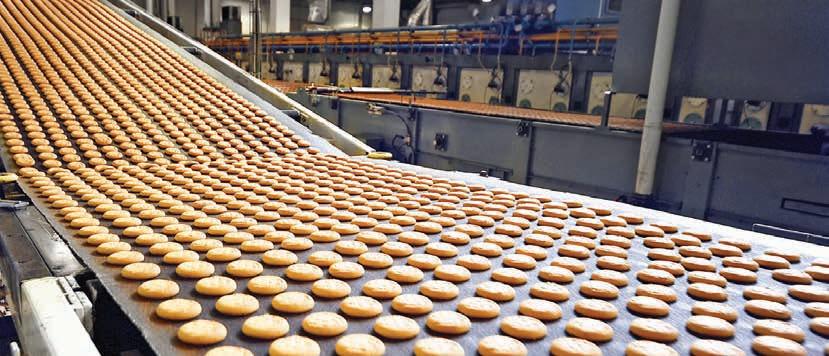
www.schaeffler.com.au

Eliminate machine failure and food waste with Lifetime Solutions
Reduce waste Extend equipment life Minimise energy consumption
We pioneer motion Plug and
play.
Advanced monitoring.
Accurate monitoring requires the right instrumentation
AMS and Katronic supply the Australian food and beverage industry with some of the highest rated and popular flowmeters, which already have a proven track record.
When Molson Coors Brewing Company was in the market for a reliable, robust, and accurate method for monitoring performance of its brewing, cleaning, and processes, they contacted Katronic for assistance.
Katronic specialises in clamp-on, ultra-sonic flow metres and non-invasive process measurement instrumentation and modern electronics and sensor technology.

The company was established in the United Kingdom in 1996 as a distributor of process measurement instrumentation with a focus on ultrasonic technologies.
Since then, the company has evolved into being a highly regarded manufacturer of its own brand of clamp-on flowmeters and works tirelessly to maintain an excellent reputation for quality products and market-leading customer service.
AMS Instrumentation are the distributor of Katronic machinery and technology within Australia and the success of Katronic’s work with the Molson Coors Brewing Company is a great example of how the partnership between the two companies is benefiting the industry.
One of the problems faced by the Molson Coors Brewing Company’s engineering team was the lack of


verification methods for its existing in-line flow meters, or for measuring pipelines where flow metering was absent to begin with.
This was of particular importance when it came to the clean in place entries and on the water supply pipes where the system had been in operation for a significant period of time.
That also applies to the plant’s effluent overflows where strict environmental standards must be met.
Solution
The solution given to the Molson Coors Brewing Company came in the form of a Katronic portable clamp-onflowmeter. By having the KATFlow 230, the engineers at the brewing company were then able to carry out a complete survey of all critical pipelines within the production process.

As all measurements were taken non-invasively, it ensured that there was no need to interrupt the production lines, and by extension removed, any risk of contaminating the flowing liquid.
Furthermore, as the flowmeter can be programmed and the sensors installed very easily and in short time, several pipelines could be measured in a short period of time.
The implementation of the Katronic flowmeter was successful and has proven popular with the engineering team at the Molson Coors Brewing Company.
As a result, the engineering team commented that they were ‘highly satisfied’ with the high specifications of the unit, the ease with which it can be used, and the excellent build quality of both the sensor and the electronic transmitter.
Some of the listed advantages of the KATFlow 230 also includes the simple, quick and cost-effective installations and measurement capabilities, no interruptions to ongoing production processes, and the option to integrate temperature inputs for greater process control.
On top of these advantages, the KATFlow 230 is also capable of measuring different pipe materials and diameters, is easily portable throughout the whole plant and a robust, reliable, and accurate instrument.
AMS can help Australian food and beverage manufacturers get hold of any of the Katronic clamp-on ultrasonic flowmeters.
AMS has been supplying instrumentation to most, if not all, of the industries in Australia for almost half a century, from government departments to public utilities and food and beverage manufacturers.
Having Katronic as part of the company’s suite of offerings means Australian manufacturing has access to proven, and popular, technology.
28 Food &Beverage Industry News | December 2022 | www.foodmag.com.au
FLOWMETERS
F
AMS Instrumentation are the distributor of Katronic technology in Australia.
Katronic’s flowmeter offerings have already proven popular in Europe.



Demand for F&B industrial space is the highest it has ever been

As the food and beverage industry continues to recover from the impact of the COVID-19 global pandemic, several of the disruptions caused by the event have also resulted in supply and industrial space concerns in Australia.
CBRE Australia, a commercial real estate group, has seen firsthand how disruptions to the supply chain, and changes in consumer demand off the back of extended lockdowns, has impacted the industry.
“There has been a huge take up over the last couple of years, occupiers have been taking additional space because
supply chains have been unreliable and consumer demand increased dramatically,” said Michael O’Neill, CBRE NSW director and managing director of CBRE Western Sydney.
“Many occupiers have moved to a ‘just in case’ model rather than the traditional ‘just in time’ model.
“That has created demand for extra space and contrary to that is the supply of new stock has not kept pace with that demand. Whether it be delays due to COVID, delays due to wet weather, and delays with planning.
“These factors mean users have wanted more space but there has been
less supply.”
As an example, 2021 saw the highest take up of industrial space ever in Australia, and by a significant amount, O’Neill added.
Traditionally the gross take-up around the Sydney area has been dominated by postal, transport, and warehousing over the last decade, but in the last two years that has seen an increase in a range of industries particularly food related groups.
“This is largely due to an increasing e-commerce penetration rate,” said O’Neill.
“A lot of people have gone to 3PL’s for
overflow, however the manufacturing sector, which includes food production, has represented a significant part of that, 21 per cent in fact.
“The penetration rate will continue to increase, and I think population growth will keep that momentum going moving forward.”
The growth seen over the last two years is trickling across all sectors of the food and beverage manufacturing industry, including at the retail level, which is helping drive the demand for more stock and industrial space.
“With respect to non- discretionary retail spend, this has been growing at an
30 Food &Beverage Industry News | December 2022 | www.foodmag.com.au
WAREHOUSING
The food and beverage industrial sector experienced a record uptick in the demand for more industrial space off the back of several external factors including the pandemic and supply chain disruptions.
Adam McCleery writes.
10 billion in 2021, and expected to double to AUD 20 billion by 2026.”
These changes have also resulted in new approaches to the types of industrial buildings companies are now looking to construct.

“We are seeing that many developers recognise the strong demand by specialised food users, especially in in-fill locations like Auburn but also in outer west locations like Eastern Creek and Glendenning,” said O’Neill.
“I would estimate that for somewhere between 30 and 40 per cent of occupiers on new development stock on inner locations is being driven
challenges is that supply is so tight that developers do not necessarily need to build specialised buildings to attract occupiers because demand for ambient space far outstrips supply.
Figures from CBRE Research also show that Australia’s food and beverage exports totalled $47 Billion in 2021, which made up 10 per cent of the nation’s total merchandise exports and is expected to increase to $66 Billion in 2026 off the back of Australia’s comparative advantage in food production.
“The growth in the food and beverage industry, associated
comparative advantage in food production, coupled with strong export ties with countries exhibiting a growing middle-class population, we expect further expansion of Australia’s food and beverage sector.”
These industries which fall under non-discretionary retail trade sector underpin the long stability of the industrial and logistics sector and by extension the cold storage sector.
All of these factors mean the demand for space and the industrial space available, is imbalanced significantly, O’Neill said.
“At the moment, the vacancy in
The demand for industrial food facilities is far outsripping the current supply.
O’Neill added that occupiers in all industries were well advised to consider their requirements no less than 18 months in advance to ensure they can consider green field solutions.
“The prevailing market conditions mean that occupiers will need to compromise if they are not in the market 18 months from their desired commencement date.
“ There are definitely some ideal pre-lease and speculative solutions provided occupiers engage earlier than in the past. There is always the chance of finding a good solution with 6 months lead time, but it’s unlikely.” F
www.foodmag.com.au | December 2022 | Food &Beverage Industry News 31
WAREHOUSING
"The growth in the food and beverage industry, associated manufacturing, and distribution operations, is led by both domestic and global demand factors."
In-line Cryogenic Freezing: a tailored solution
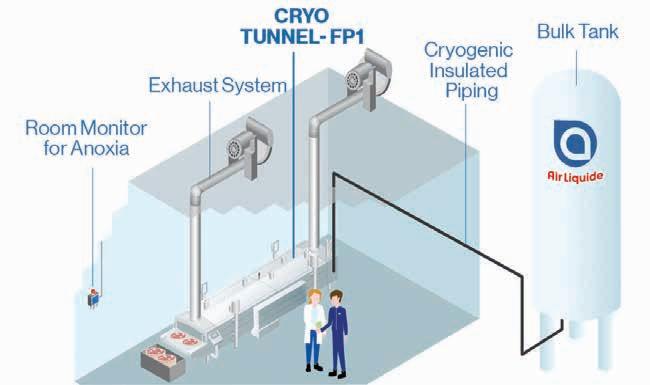
Air Liquide provides expert knowledge and experience for the best cryogenic freezing solutions. Food & Beverage Industry News reports.
Time is of the essence when it comes to freezing. Cryogenic freezing is a niche application in the food refrigeration market and refers mainly to the use of liquid nitrogen and liquid carbon dioxide as the refrigeration mediums.
The colder temperatures of these cryogens enhance the quality of the food product by freezing it much faster than with traditional freezing methods.
Faster freezing results in the formation of smaller ice crystals which causes less damage to the cellular structure and helps to retain the food product’s initial texture, colour, and flavour attributes.
In addition, cryogenic freezing contributes to higher yields by rapidly locking in the product’s moisture content so that there is very little weight loss from dehydration during the freezing process.
Integrating a cryogenic freezing solution into a new or existing production line involves a good understanding of the composition and properties of the food product that needs to be frozen, along
knowledge and expertise, through its worldwide network of food cryogenic specialists and research laboratories, to be able to design the most cost-efficient cryogenic solution that is customized to meet the specific needs of each manufacturer.

Air Liquide also offers an extensive range of cryogenic food processing equipment, in various models, widths and lengths, that can be perfectly matched with the food product, production volumes and amount of available floor space.

Cryogenic freezing equipment solutions are extremely flexible and can be easily customized based on the different characteristics of the food product.
For example, the conveyor belt that is selected for a cryogenic freezer is chosen based on the type of food product that is being frozen.
There are several different types of conveyor belts that are available, each with its own particular set of attributes: stainless steel mesh conveyor belts; stainless steel plate-link belts and foodgrade polyester conveyor belts.
Finding the right cryogenicfreezing solution is critical.
available in different mesh opening sizes which can minimize any product losses in the cryogenic freezer while still allowing the cold gases to circulate more evenly around the food product for better freezing efficiencies.
However, there are instances where the product is too small (i.e. grated cheese, cooked pizza toppings) for even a very fine mesh opening conveyor belt.
In these cases, the product can clog up the belt mesh or even fall through the
steel plate-link or polyester belt is better suited for these types of products since these are “solid-type” belt materials that will ensure that the product stays on the conveyor and is carried through the freezer without any losses.

Food products with fragile, soft or sticky characteristics (i.e. marinated chicken breasts, chocolate coated products), can quite often stick to stainless steel conveyor belts, either leaving belt marks on the product or making it difficult to remove the product without any damage or deformation.
Using a solid non-metal belt material like Air Liquide’s food-grade polyester belt, is a great alternative. This belt is saturated with liquid nitrogen using an innovative, patented liquid nitrogen belt wetting technique that enhances the overall freezing process.
The bottom surface of the product, when placed onto the polyester belt, freezes immediately which prevents any sticking to the belt so that belt marking is reduced, and product deformation or damage is eliminated.
Air Liquide has been providing innovative solutions to the food industry throughout the world for over 50 years.
Every solution is specifically designed for each food processor using Air Liquide’s ALIGAL food grade gases, state-of-the-art application equipment and food cryogenic technical support services. Air Liquide customers benefit from being able to produce value-added, high quality food products at a competitive cost. F
CRYOGENIC FREEZING 32 Food &Beverage Industry News | December 2022 | www.foodmag.com.au
Air Liquide offers a host of solutions for better cryogenicfreezing.






World Class Facility Construction | Call: (02) 9746 9555 | Visit: totalconstruction.com.au Looking to build or expand a Ready Meals facility? Call Total Construction to see how we can help from concept to completion of your project.
What comes next? Planning a carbon free future
Food industries must become more resilient in the face of a changing industry landscape on the back of new sustainability targets and expectations, NIRAS managing director Edward Lynch said.

The United Nations projects increased demand for food supply of some 50 per cent in coming years simply to accommodate population growth. At the same time, food industries are trying to become more resilient, consumer focused and carbon neutral, while climate change is putting supply chains and vast areas of land used for crops and livestock at risk.
“You can think about, ‘How do we make the food system lower carbon?’ Or you can think about, ‘How do we feed an extra two billion people?’,” said Jessica Alsford, Morgan Stanley.
“But you can’t really analyse them in silos, because the two have a real impact on each other.”
Food processors and manufacturers traditionally operate in relative silos, oftentimes struggling to individually implement innovation, increasing their susceptibility to disruption, as evidenced by the recent coronavirus pandemic. While innovation and application of technology can help build resilience, adoption in Australia has traditionally been slow.
For most companies it’s a challenge of transition. While most can articulate where they want to be, very few can
clearly articulate a transition path, taking them from where they are, to where they want to be.
NIRAS is a knowledge organization originating in Denmark, working globally in the food and fibre industries around the world.
NIRAS is working extensively with Australian and international organizations to plan and implement these transitions to colour a more effective and resilient future. We discuss here the need for clarity in transition planning to optimise the opportunities that a decarbonised future presents to the Australian food processing sector.
“Climate change is increasingly creating challenges and disrupting business as usual operations,” said Edward Lynch, managing director NIRAS Australia.
“Whether organizations are threatened by environmental risks such as flooding, fires, or disruption to natural and human resource, or organizations are impacted through damage to brand reputation, business models, supply chains and margins, their business are at risk.”
At the same time climate change is creating genuine opportunities for
businesses to strengthen brand, reinforce customer loyalty and exert positive influence over supply chains, partners, industries, and society.
Leading producers, processors and manufacturers will embrace the challenge. Those who don’t will be left behind.
The impacts of climate change will likely be far more destabilising than the disruptions of the recent pandemic. Organizations that respond positively and decarbonise their organizations and their supply chains will build natural resilience and resistance to these risk; creating significant opportunities for their bottom lines.
“Decarbonisation is not just about emissions and resource conservation, it is the future of good food business.” Glenn Jacobsen, sector lead Food and Fiber, NIRAS Australia.
Decarbonisation has the ability in the food processing and agri-sectors to

• Attract and satisfy investors and key stakeholders
• Grow brand recognition and influence
• Demonstrate industry leadership
• Attract and retain top human talent
• I mprove business economic and value
• Conserve resources and improve financial bottom line
• Drive innovation and change
• Differentiate from market and product competitors
Investors, institutions, governance structures and leaders have clearly identified the value in decarbonisation, creating real pressure on organizations and businesses to respond. This is clearly demonstrated through
• Growing strength and priority of environmental, society and governance (ESG) indices and high performing asset classes
• A lmost 200 countries and the European Union have committed to the Paris Agreement to substantially reduce greenhouse gas emissions and control temperature rise to 1.5 degrees Celsius
• European Union leaders, European Parliament and European Commission have committed some 750 billion Euro in funds targeted at ensuring a sustainable and future resilient recovery in Europe
• CEOs from the world’s largest economies believe that climate response will create new opportunities in goods and services
34 Food &Beverage Industry News | December 2022 | www.foodmag.com.au
Resilience is critical for evolving food landscape.
SUSTAINABILITY
• I
nstitutional investors are mandating sustainability and risk mitigant to climate risk
Consumers are increasingly concerned with the ethics and environmental credentials of the products they purchase. This is forcing manufacturers and producers to shift from product focused to purpose driven. More civically minded brands are communicating this sense of purpose. When purpose is proven to customers, profits follow.
Manufacturers who control standards and sources across supply chains are meeting customer expectations for companies to be ethically and environmentally responsible.

Manufacturers need take their responsibility to the people, communities, and environments involved in their supply chains seriously. They are hiring employees whose personal values align with business values and extends to using technology to keep employees safe. Manufacturers
are also priortising social and environmental issues beyond the factory floor. At the centre of supply-chain innovation is a quest for fairer materials and more responsible practices.
Increasing successful organizations are realizing that
• Purpose equals profit
• Success comes through attracting and protecting talent and
• T he future demands responsible resource management
Decarbonisation is arguably a clear and present objective, however establishing the pathway is full of obstacles and challenges, particularly for operational businesses and their supply chains and partners. Any such commitment demands technical, financial, organisational and governance capability and capacity which cannot distract from core business activity.
In establishing and implementing a decarbonisation pathway organizations should be asking themselves four key questions:
1. W hat does success look like?
2. W hat targets and goals are appropriate?
3. How do we deploy organisational, physical, financial and technology solutions?
4. How do we sustain and improve results?
While decarbonation is a circular and iterative process, defining success and organisational aspirations is the first steppingstone on the pathway, requiring alignment on vision and strategy. NIRAS through our work globally in food processing industries and our commitment to the green transition, can provide baseline analysis, relevant global industry and market intelligence, and trends, prepare benchmarking and lifecycle and footprint analyses, engage stakeholders, prepare financial analysis, and map the journey.
This work with organizations equally need establish time based goals and targets, crucial to any decarbonisation strategy. In analysing risks and opportunities we can validate target options and scenarios, performance
levels and funding structures.
Through this understanding and planning, organizations must them identify solutions, and optimise their procurement and deployment. NIRAS are working across all sectors of the food and beverage industries in Australia to optimise solution procurement, account for resource use, leverage electrification, source suitable finance and funding strategies and promote suitable and appropriate partnerships and collaborations.
Further in order to sustain results, there needs to be an on-going commitment to track and analyse performance, review operations for continuous improvement opportunities and to openly report and communicate.
The opportunities for new products and services to meet future challenges for the food industries globally and in Australia, are enormous.
The brave will seize these opportunities and increase their resilience. Those who do not, will be left behind and vulnerable. F
An ongoing commitment to tracking and analysing performance is another key to sustaining results.
SUSTAINABILITY
Don’t get caught out when upscaling temperature-controlled environments
Paul Brady, owner, and founder of Paul Brady Building Group has been in the food facility construction industry for over 25 years and specialises in helping food and beverage manufacturers mitigate the risks of upscaling and meeting greater production yields.
Brady said because of the growth strategy of many of PBBG’s clients, being able to help them from scratch was critical to limiting turnaround times.
“The companies we generally do work for have grown the business quickly and have an opportunity to
obtain contracts with big suppliers, but they find themselves needing to move into a new facility,” he said.
“By nature of that opportunity, a quick turnaround time is required, which creates a lot of pressure.”
“And if they have moved into an older facility, it won’t have the accreditation specific for that type of manufacturing, so in those cases we sit down and we work from scratch.”
Brady said Paul Brady Building Group mostly specialises in brownfield sites, which is a new fit out within an existing warehouse.
“We need to take many construction, compliance, and food production elements into account but we have had clients buy a warehouse or factory and find that it wasn’t suitable,” he added.
“They might be a meat producer but have bought a facility close to residential properties which creates issues around EPA.”
“We are all about mitigating the risk for our clients and helping them find the right property to grow their business so we talk to them about future growth and how it can be incorporated into today’s design.”
There are so many things to consider when upscaling and lead times can be considerable, so being prepared and planning ahead is critical, especially in food and beverage production.
As highlighted by the seafood supplier case study, PBBG understands the need for high-quality floor finishes and the best in breed building materials, including FM approved insulated panel walls and ceilings.

“We custom manufacture our own range of insulated door systems in house. We also have exclusive distributorships for other high quality fixtures and
Paul Brady has been in the food construction industry for over 25 years.
COLD CHAIN
Among PBBG specialities is the expert ability to fit out temperature-controlled environments.



fittings that we import and insist on for our projects,” said Brady.
“We closely look at all aspects of our clients’ operations and we are able to bring into the project products/systems
that we know will work best in that environment for greater performance and longevity.”
The added focus on high-end flooring finishes has also become a
point of pride for PBBG and is one that is of supreme importance to food and beverage manufacturers.
“We see the fall out of poor-quality floor systems and finishes that aren’t up to the demands of the production areas, so we invest in researching and installing hard-wearing floor systems.
“We import some products from Europe that we incorporate into our range.”
But one of the biggest strengths of the company is the capacity to do all the insulated panel installation by its own trained and experienced staff.
“As the principal contractor we bring in quality specialists that complement our higher build quality,” said Brady.
“By identifying with the client early on what they need to be aware of, they are more likely to avoid nasty surprises down the track,” he said. F
PBBG is able to help clients from the very start, helping to improve turnaround times.
www.foodmag.com.au | December 2022 | Food &Beverage Industry News 37
Helping address the shortage in industrial freezer space
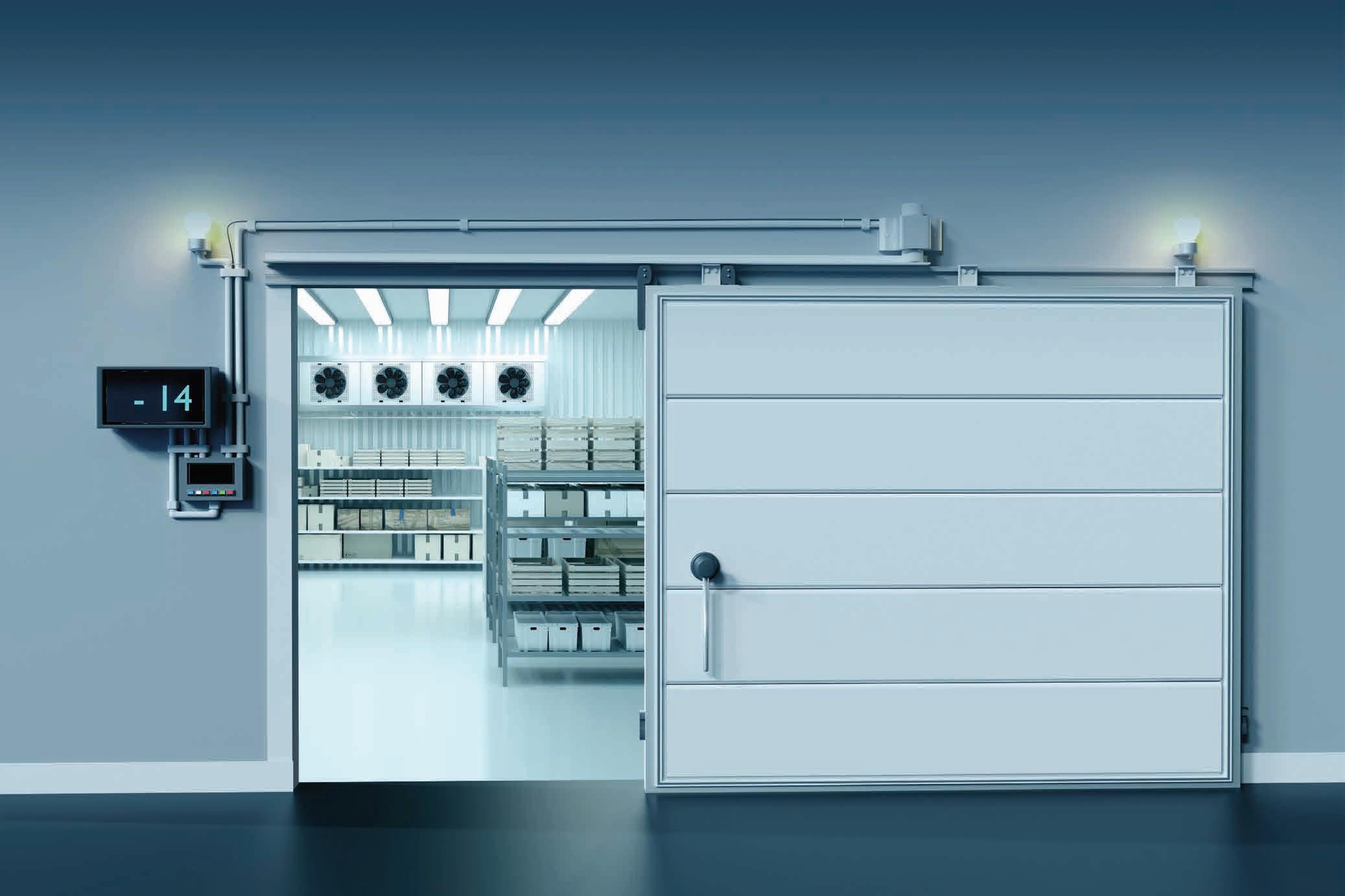
The Australian food and beverage manufacturing industry is experiencing a shortage of freezer space, but the like of Total Construction is helping to mitigate the issue. Adam McCleery writes.
The cold chain was put under the microscope during the COVID-19 pandemic, and in its aftermath, after disruptions brought some of long-standing issues into focus.
Rob Blythman, general manager of Total Construction’s engineering construction group, said the massive shortage in freezer space was especially prominent in the cities.
A large developer looking to construct or repurpose cold chain spaces across Australia contacted Total Construction for its help, which has resulted in the construction company assessing a number of existing spaces across the country.
This assessment drive has given the company added insight into the
challenges which need to be overcome when building or repurposing industrial freezer space.
“Recently we’ve been evaluating facilities for a client and a developer that wants to repurpose or upgrade freezer sites and then lease them out to whoever wants to store product,” said Blythman.
“They are looking at gathering a large amount of these stores, that they’ll own around Australia, they will be leasing to clients.”
The most prevalent issue the team from Total Construction has identified is around fire safety and insurance.
“The biggest issue we found is that a lot of the freezers we look at are EPS, which is the cool room panelling and
isn’t fire rated,” added Blythman.
“The major issue is that the clients are going to be putting food inside those freezers and they will find it difficult to get insurance on their products.”
B ecause of this, developers like the current Total Construction client must first weigh up the factors around building up, repurposing, or tearing down and rebuilding a facility.
“When they look at these facilities they need to consider if they want to rip out all the EPS and replace it with fire retardant PIR of XFLAM, which are the two main products on the market. It is rather costly but not insurmountable,” said Blythman.
In many cases, other factors can take
the final decision out of developer’s hands.
“A lot of the refrigeration plants are also old and need updating or replacing totally, for example major problems can happen with the slab,” said Blythman.
“There might be some heaving in the slab in these old freezers because the under floor heating system, which may be glycol or heater mats, is broken or not operating properly.
“We’ve seen freezers where they’ve had to cut up the floor and replace some of the glycol pipes because they are broken.
“Once you don’t have that under floor heating the problem is your slabs will heave because of the temperature difference between the ground
38 Food &Beverage Industry News | December 2022 | www.foodmag.com.au
COLD CHAIN
The demand for industrial freezer space is currently far greater than the supply.

underneath and the freezer above. It causes the concrete to lift and crack, it creates a host of problems.”
Many developers across the country are moving towards developing or repurposing industrial freezer space because of a growing confidence that the massive demand for the space means the investment is sound, if the correct space is found or built.
“It’s definitely a good business model because of the massive demand out there but this is more about the detail where that business model can fall down when you have to effectively replace the whole building,” said Blythman.
“ Worst case scenario is you are looking at a significant investment because these building can be over $3,000 a square metre to fix, and that’s not including your refrigeration update
if that is needed.”
Blythman said site selection is the most important factor.
“The consideration is that if you need to knock down a freezer then why bother going there, go to a different site and build a new one,” said Blythman.
Total Construction helps with making this choice as effective as possible.
“ We are dealing with a company that is doing all of that and working out what the best model is for individual sites across the country,” said Blythman.
“We’ve looked at the sites and advised accordingly, you can ‘sweat the assets’ so you don’t do anything to it and utilise it as is, for as long as you can, until it must be ripped down or upgraded.”
One way around the issues regarding the lack of insurance against fire in EPS freezer storage is the fact many of the freezers are independently owned and therefore the producer is willing to take on the risk instead of undertaking the large cost of upgrading or rebuilding.
In many cases, a retrofit, internal only, is a good solution with less overheads. So again, site selection is critical.
“Usually, the structure that is holding it up is sound, so you strip out all the EPS and rebuild the freezer on the inside,” Blythman said.
“It just depends on the construction of the facility, if all your external walls and your roof are EPS panel then you are just knocking down the whole building whereas a lot of warehouses that have been fitted out with panel
and they are easier to retrofit.”
Blythman agreed there would be EPS freezers remaining in the market for many years to come, but as demand grows, so will the need to update these old facilities.
“Clients recognise the risks of storing in EPS freezers, and you will always have clients that will put their product in there,” said Blythman.
“But if you want to target the big players then you need to have the capacity to insure their product while it’s in storage.”
As the cold chain strengthens, on the back of better tracking technology and handling practices, the demand for industrial freezer space will only continue to grow and selecting the right site, for what is needed, is possibly the most critical step for any developer looking into the space. F
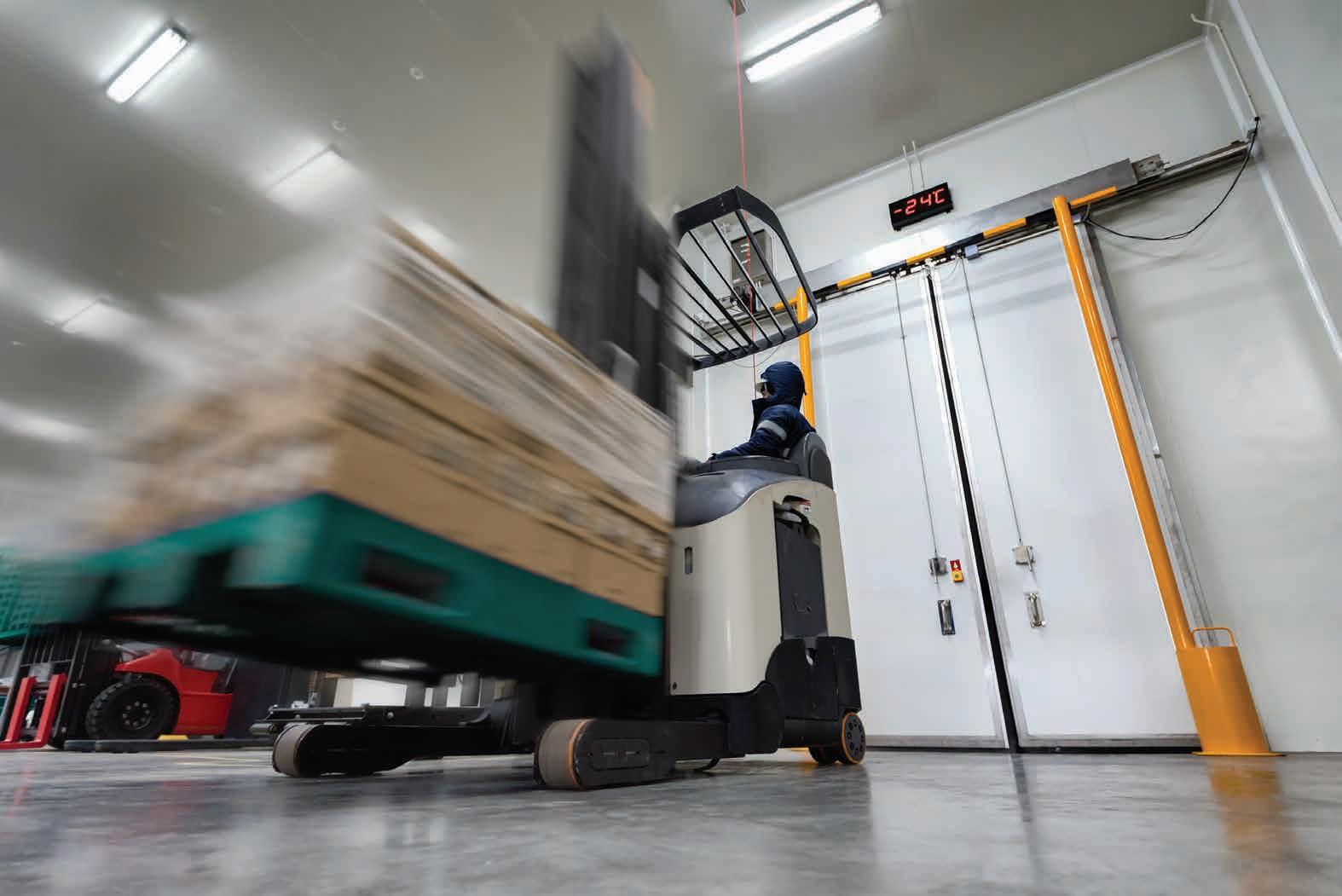
COLD CHAIN www.foodmag.com.au | December 2022 | Food &Beverage Industry News 39
Total Construction has found that EPS panelling is a key issue with old industrial freezers.
250,000 products have ARL on-pack
In the last four years retail stores in Australia and New Zealand have seen over 250,000 retail products replace misleading logos on pack with clear and intuitive consumer-facing Australasian Recycling Labels.
We are seeing the momentum picking up pace with more brands working towards removing recycling logos that can be confusing for consumers such as the Trash Bin man symbol and the Plastics Identification Codes (PIC).
The latest ARL Consumer Insights Report identified that consumer awareness levels about the Australasian Recycling Label (ARL) are also increasing, and more people are recognising the logos on -pack.
According to the report the strongest awareness of the ARL comes from the 16- to 24-year-old age bracket, followed by 25-34 and continues to decline when you hit the over 65 age group.
75% of consumers agree that the ARL on-pack is a great idea and want to see it on all packaging, with 50% of Australians more likely to buy a product which includes the ARL on-pack.
Dissecting the Australasian Recycling Label (ARL)
The Australasian Recycling Label (ARL) is an evidence-based on-pack labelling program that provides easy-tounderstand instructions about how to correctly dispose of a product’s packaging.

The ARL Identifies if the packaging, and all separable components, can be recycled or not in our region. The logos are specific to each pack and identify whether the packaging should be disposed of in the kerbside bin or the non-recyclable bin. This process is undertaken via the Packaging Recyclability Evaluation Portal (PREP) before the ARL is approved to be applied on-pack. PREP simulates the recycling ecosystem including the collections systems, technical recyclability and available end markets for materials.
The ARL then identifies whether it is recyclable, conditionally recyclable or non-recyclable and the logos match the assessment. This system also ensures that each component is assessed for true collection, sortation, recovery and recyclability capabilities for the region.
The Consumer Insights report also recognised that consumers would like more information about what they can and can’t recycle as they are concerned they are not recycling properly. The ARL takes away all of the guess work as the logos are intuitive and enable everyone to be able to follow simple instructions for correct disposal of the materials and pack components, such as the lid, tray or wrap.
Benefits for Brand owners and packaging manufacturers
There are significant benefits for brands to have the ARL on-pack as it a guarantee that the materials, separable components and finished packs have been reviewed and assessed for true recyclability in the ANZ region.
The ARL supports brand owners and packaging manufacturers to meet the 2025 National Packaging Targets
by designing out waste, eliminating any problematic materials and ensuring that the packaging is recyclable for the region it is sold in.
The program enables brand owners and packaging manufacturers to contribute to a circular economy by keeping packaging out of landfill, reducing kerbside contamination and increase recycling rates and access to quality feedstock that can be used in circular packaging design. Ultimately, we want to be able use the materials over and over again in more packaging in the future wherever possible. The ARL ensures that packaging materials can be captured and processed into new products.
Benefits for Consumers
The ARL program cuts through all the confusion currently on the market and helps to aide consumers to recycle
correctly. From a marketing perspective if you are not currently considering implementing the ARL on your packaging then you are missing out on benefits to your business and your consumers.
The ARL should also be seen as a unique marketing tool that communicates to consumers the recyclability of the packaging, improves recycling behaviours and brings them on the recycling journey with the brand. By having the ARL on-pack the brand is demonstrating their commitment to lowering their environmental impacts.
We look forward to seeing more packaging on shelf with the Australasian Recycling Label (ARL) and the AIP are here to guide you through the process.
Nerida Kelton MAIP E xecutive Director – AIP VP Sustainability & Save Food- WPO
F
40 Food &Beverage Industry News | December 2022 | www.foodmag.com.au
Latest ARL Consumer Insights Report identified consumer awarenessabout ARL label is growing.
Author Nerida Kelton MAIP, Executive Director – AIP, Vice President – Sustainability & Save Food - WPO
Global dairy commodity update November 2022

The outlook for dairy market fundamentals continued to be mixed at the end of October 2022.
Most of the focus is on the demand side with China sticking with a strict COVID policy until March 2023. Buyer caution persists in developing regions with the uncertain effect of inflation on dairy spending.
EU appears to have a weaker domestic market in cheese and butterfat, while the US cheese market remains resilient, shifting to lower-priced lines and to a stronger emphasis on mozzarella.
Supply-side fundamentals are mixed. While the US and EU are both growing milk, momentum is far from convincing. The US continued to post good growth over 2021, but the outlook is weaker into 2023, with cow numbers declining, and projected margins weaker.
Feed markets are likely to firm with poor crop yields and renewed threats to Black Sea trade.
The EU is enjoying some seasonal
milk growth with better conditions also against weak prior year numbers, but potential headwinds are ahead in H1-2023.
Milk prices will soften while fragile feed quality and likely weaker spring pasture growth (with limited fertilizer supplies) could easily pull milk output lower.
The EU’s energy situation is a little less dire for the winter ahead with energy prices falling significantly in October, but energy futures prices remain prohibitive. The situation is uncertain as EU members scramble to implement measures to ensure security of supply and cap prices.
Oceania milk supplies are only getting worse with the wet conditions on the North Island now likely to drag peak NZ output down by around 4-5 per cent. Australia’s export availability is also diminishing with persistent rain and flooding affecting producers in several regions. Milk output is expected to fall 4-5 per cent over the current season.
China’s eventual recovery from
COVID restrictions remains a key influence in coming months.
Milk availability appears ample there according to price and cost indicators, while demand in food service and convenience will continue to suffer from lower consumer mobility.
Maxum Foods is one of Australia and New Zealand’s principal suppliers of dairy ingredients to the Human Health and Nutrition, as well as the Animal
Nutrition industries.
Maxum Foods specialises in supplying medium to large-scale food manufacturers with high-quality dairy ingredients such as milk powders, cheese and butter.
Backed by top-level technical support and a huge dairy ingredient range, Maxum Foods have open global supply channels to source exactly what our customers need. F

www.foodmag.com.au | December 2022 | Food &Beverage Industry News 41 DAIRY
2019
2020 2021 2022 550 500 450 400 350 300 JanFebMarAprMayJunJulAugSepOctNovDec
Global trade (all major commodities in MSE (’ooot)
FLT93C Thermal Flow Switch helps clean up in demanding CIP processes
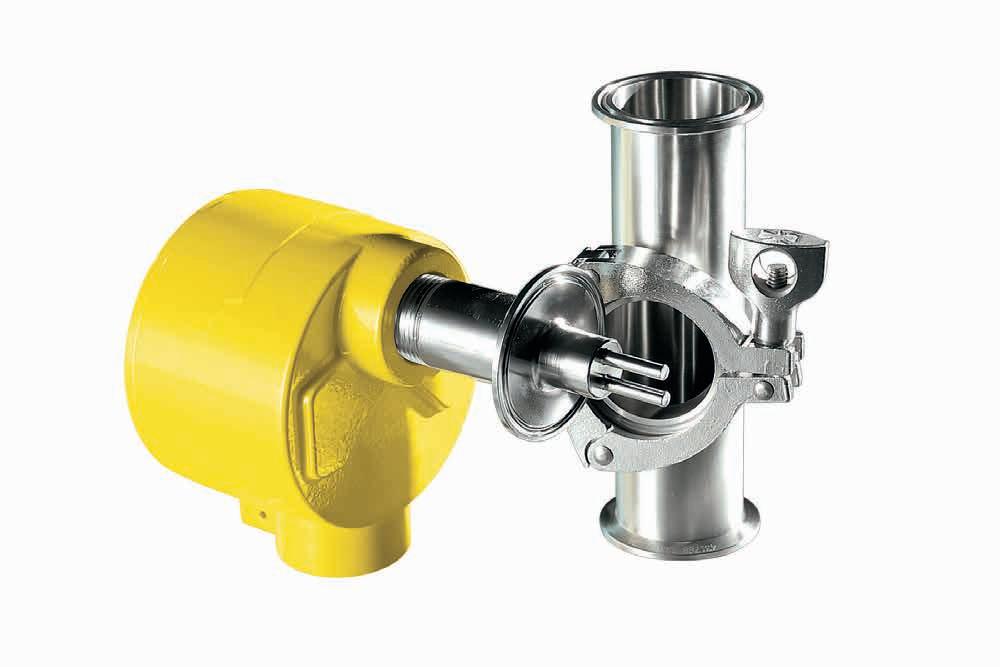
The FLT93 Series Switch is a dual-function instrument that indicates both flow and temperature, and/or level sensing in a single device.
Dual 6A relay outputs are standard and are independently configurable to flow, level or temperature.
Based on FCI’s thermal dispersion expertise, the unique sensor technology of the FLT93C Series Switches, combined with FlexSwitch™ temperature-compensation circuitry, introduces unparalleled performance measurement capabilities:
Liquid level resolution of ± 2.5 mm; repeatability of ±1.3 mm
Standard temperature accuracy ± 1°C; repeatability is ± 0.6˚C; improved temperature accuracy is available with factory calibration
One standardised, field-configurable FLT93 FlexSwitch control circuit satisfies virtually any combination of application requirements. FCI’s advanced FlexSwitch technology can be packaged in integral or remote configurations for installation flexibility.
The FLT93C Switch beats the heat, too. It is available with a choice of sensors including one that is suitable for process temperatures up to 176.67°C and one that is suitable for temperatures up to 260°C. Hazardous approvals available for the FLT93C Switch include ATEX and EAC/TRCU.
AMS Instrumentation and Calibration www.ams-ic.com.au (03) 9017 8225
MAXXDRIVE XD industrial unit specially designed for lifting applications
The MAXXDRIVE XD industrial gear unit is available as a three- and four-stage helical gear unit. The housing design succeeds follows the proven UNICASE housing principle and has been specially optimised for external loads. Due to the elongated arrangement of gear stages, the housing has a large centre distance, enabling a U-shaped drive design. Especially with lifting gear drives, the cable drum and the motor can thus easily be arranged on the same gear side same side of the gearbox. Furthermore, the housings are equipped with an inspection cover as standard.
Many options are adopted from our tried and tested modular industrial gear unit series, so that delivery times are similar to those for our standard MAXXDRIVE industrial gear units. We offer short planning and delivery times. This is made possible due to the extensive knowledge of our experts about our experts’ extensive knowledge of the specific requirements for every application, as well as optimised stocking of components.
Nord Drivesystems AUST PTY LTD www.nord.com
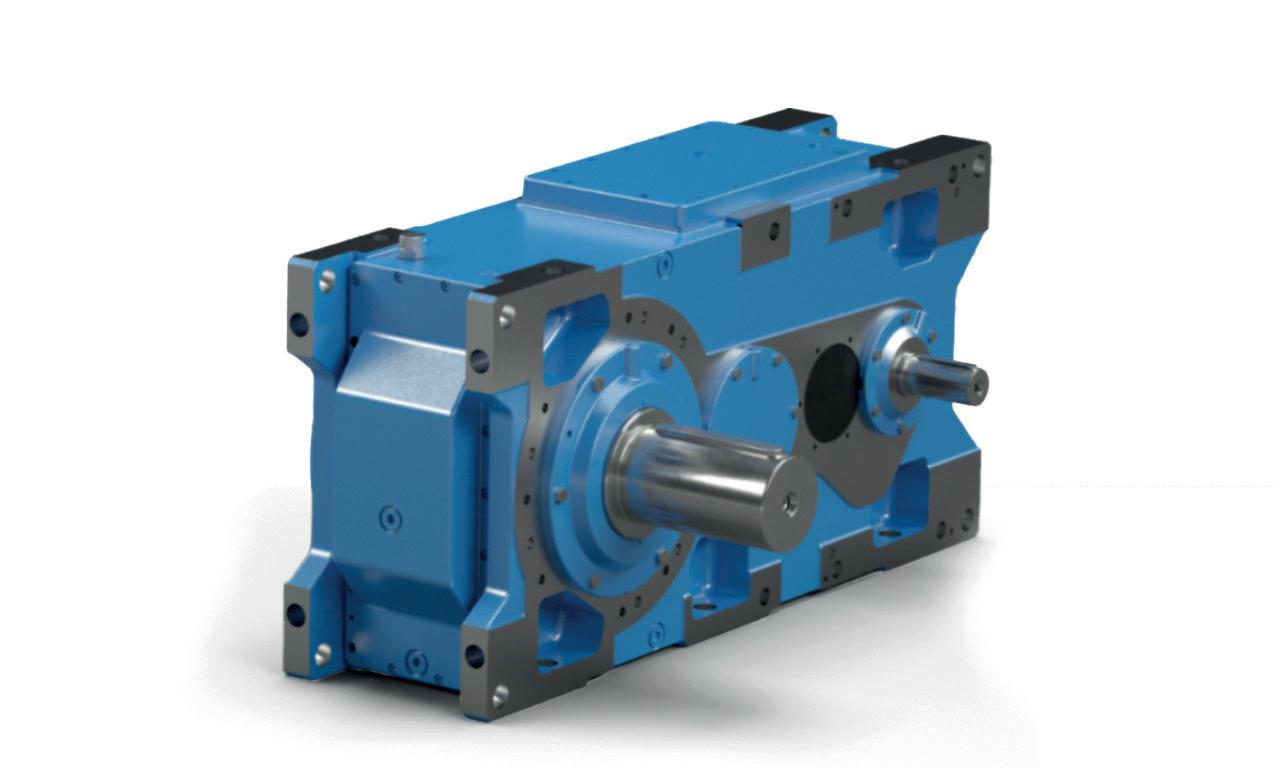
NEW PRODUCTS 42 Food &Beverage Industry News | December 2022 | www.foodmag.com.au
1800 006 673
Bullet proof your traceability targets
The 9600 is the range-topping handheld industrial scanner in the best-selling PowerScan series from Datalogic.

Achieving full traceability in manufacturing, intralogistics and retail environments is the number one priority faced by businesses today when faced with fulfilling consumer delivery demands. This IP65 and IP67 rated scanner will withstand 2.5 m drops onto hard concrete, and the trigger is tested to resist up to 10 million hits. Even though it is impervious to dirt and water, it is wirelessly charged in its cradle.
The PowerScan 9600 series of 2D barcode scanner features all the standard benefits associated with Datalogic industrial handheld scanners, but now with embedded industrial connectivity, allowing simple interfacing with a PC, Industrial PC, Tablet, or PLCs.
The 9600 rugged barcode scanner range offers three different performance levels, depending on your application, with read rates 20% faster than competitive products.
Datalogic www.datalogic.com 1800 227 263
An easy on-hand static measurement solution

EXAIR’s Model 7905 Digital Static Meter allows easy one-hand static measurements. In most cases, the highest voltage reading will indicate the source of the static problem. Sensitive and responsive, it indicates the surface voltage and polarity on objects up to ±20 kV when measured one inch (25mm) away.
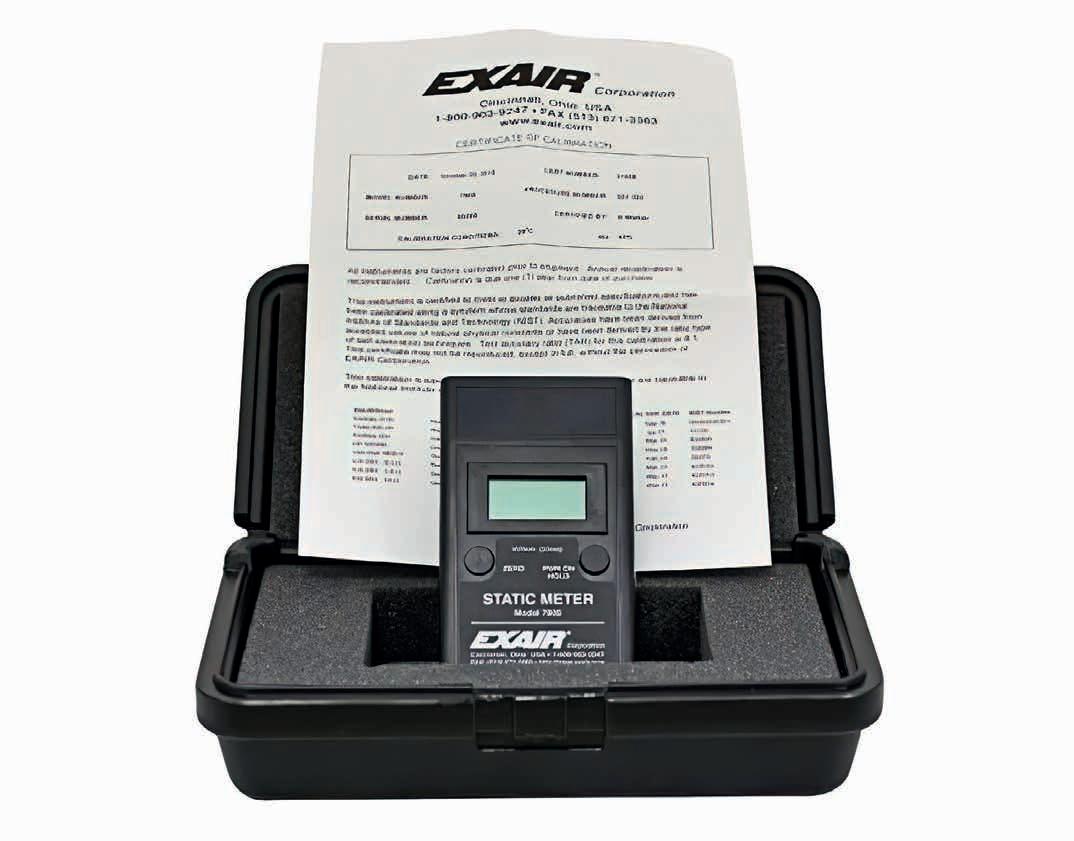
Advantages
• Indicates surface voltage and polarity on objects up to ±20 kV when measured 1” (25mm) away
• Push button “hold” for readings
• Automatic power off
• “Zero” button ensures an accuracy of ±5%.
• National Institute of Standards and Technology (NIST) certified accuracy
EXAIR
NEW PRODUCTS www.foodmag.com.au | December 2022 | Food &Beverage Industry News 43
www.exair.com 1300 476 383


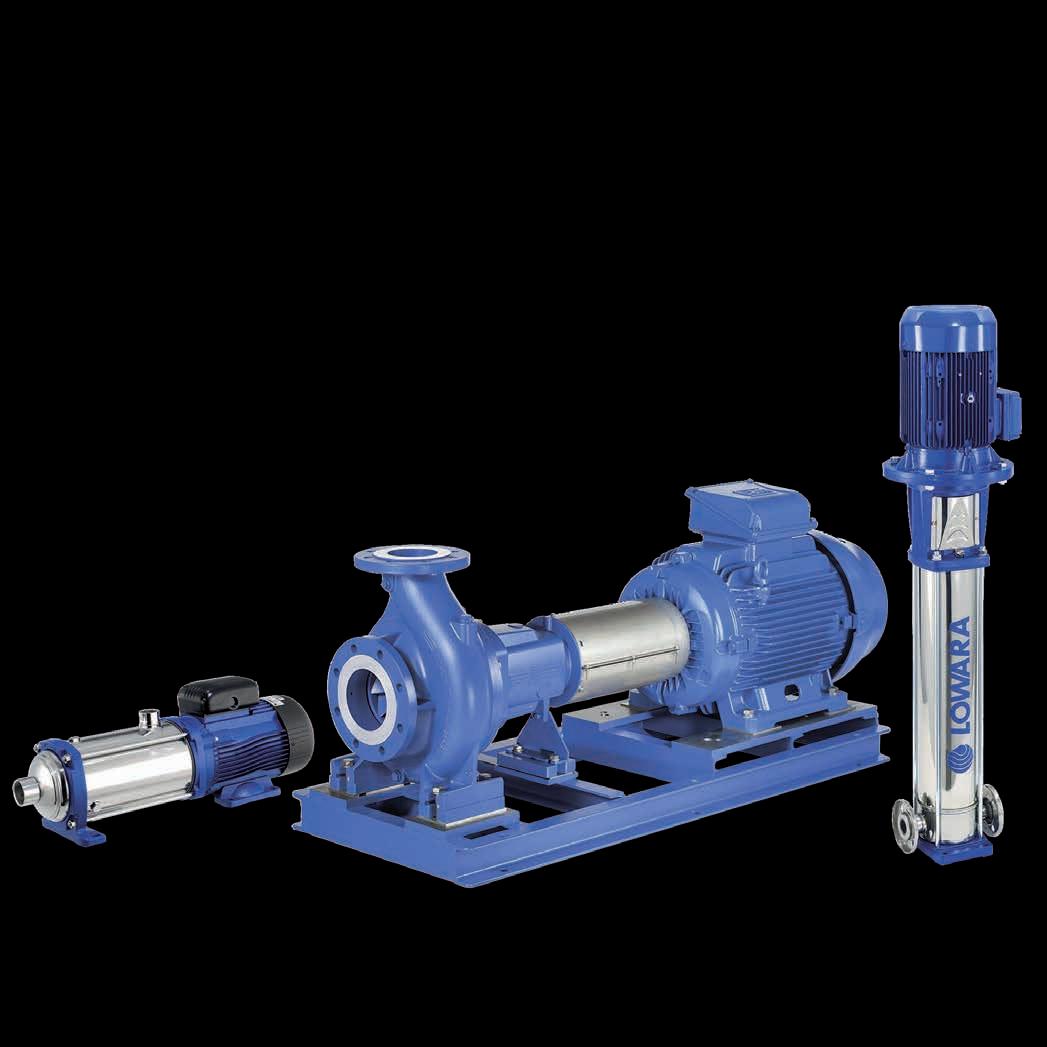
13 19 14 | xylem.com/au | solve@xylem.com
YOUR WATER CHALLENGES
Lowara brand leads the way in providing energy efficient clean water transfer solutions across the food and beverage industry. Our pumps, monitors and controls are all developed prioritising low life cycle costs and ease of use. Whether it be for food processing or water transfer, Lowara has a reliable solution for you. Scan the QR code below to find out more about our food and beverage solutions.
@xylemanz WE SOLVE
Xylem’s
CLEAN
TRANSFER SOLUTIONS XYLEM
WATER





























 Glenn Jacobsen
Edward Lynch
Glenn Jacobsen
Edward Lynch












































































